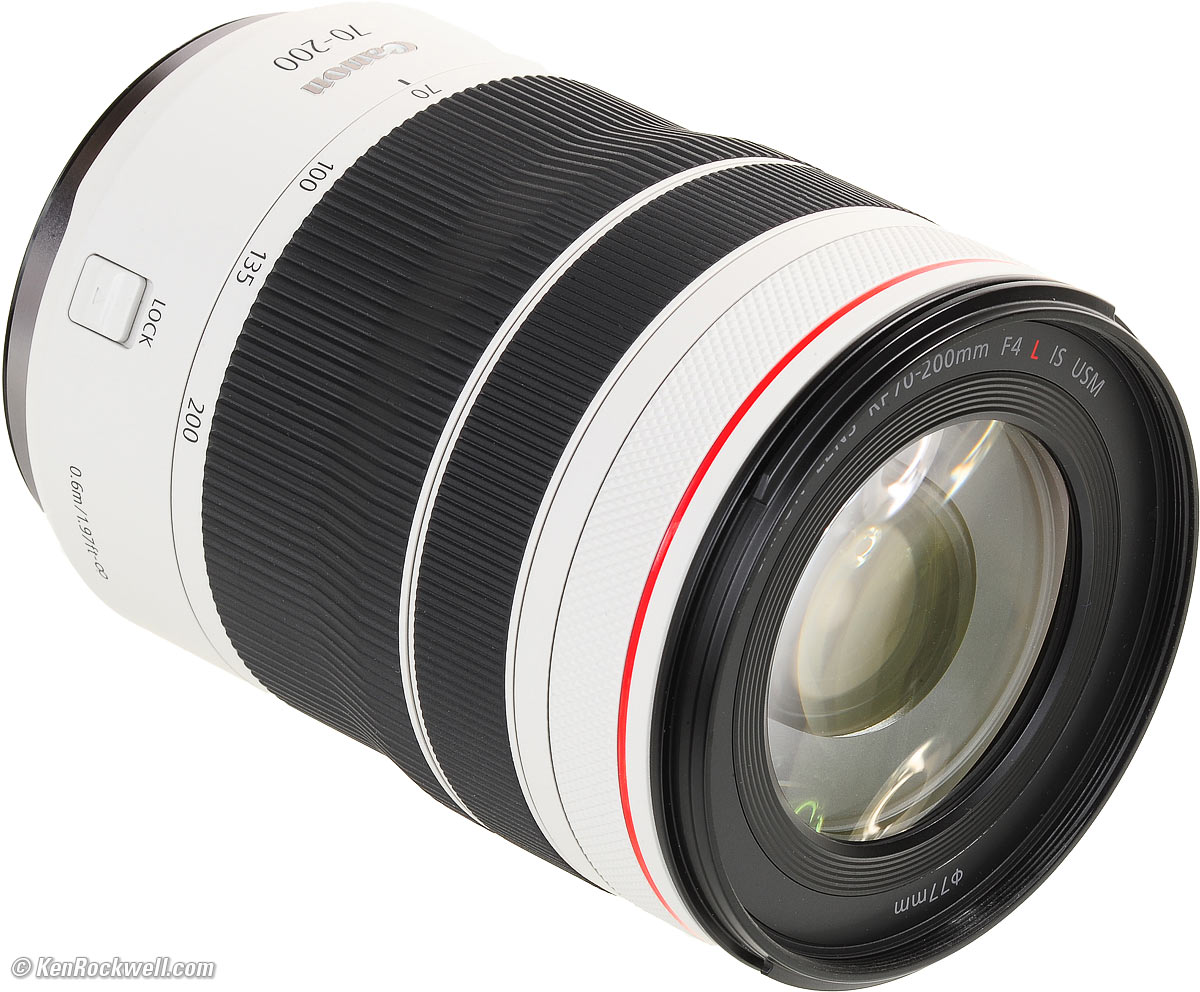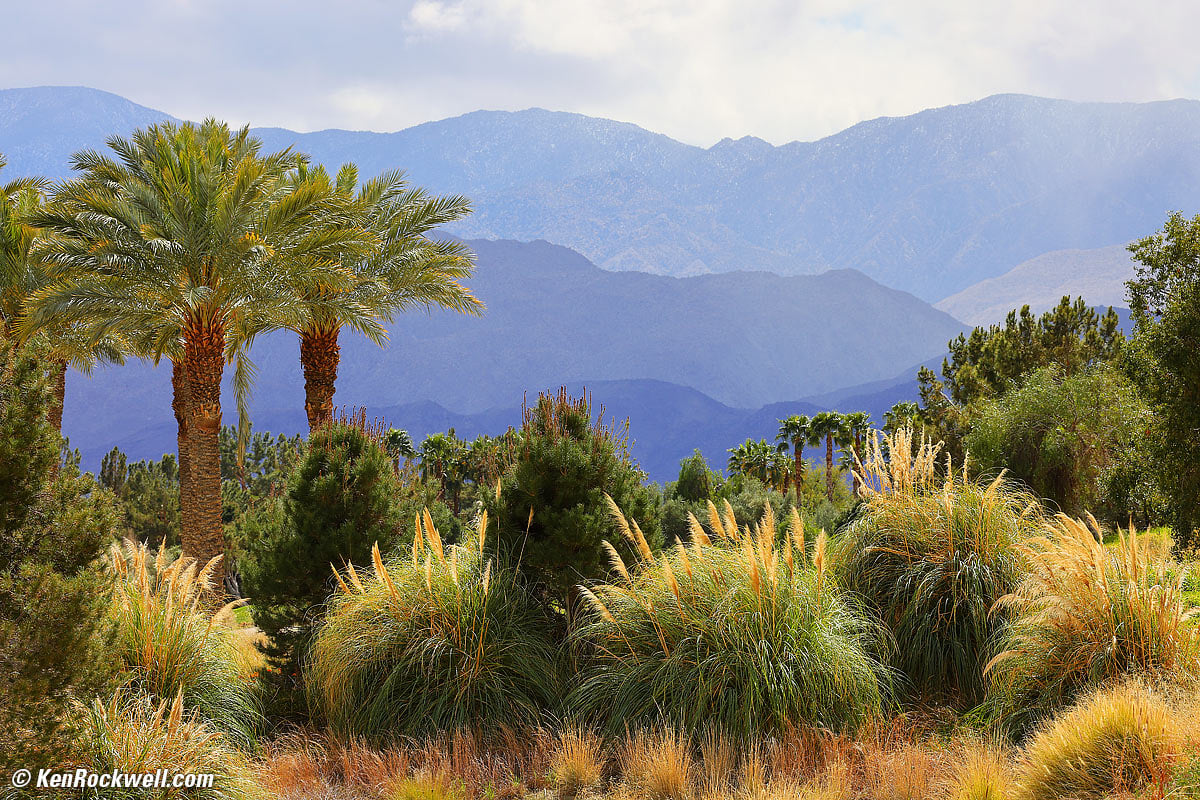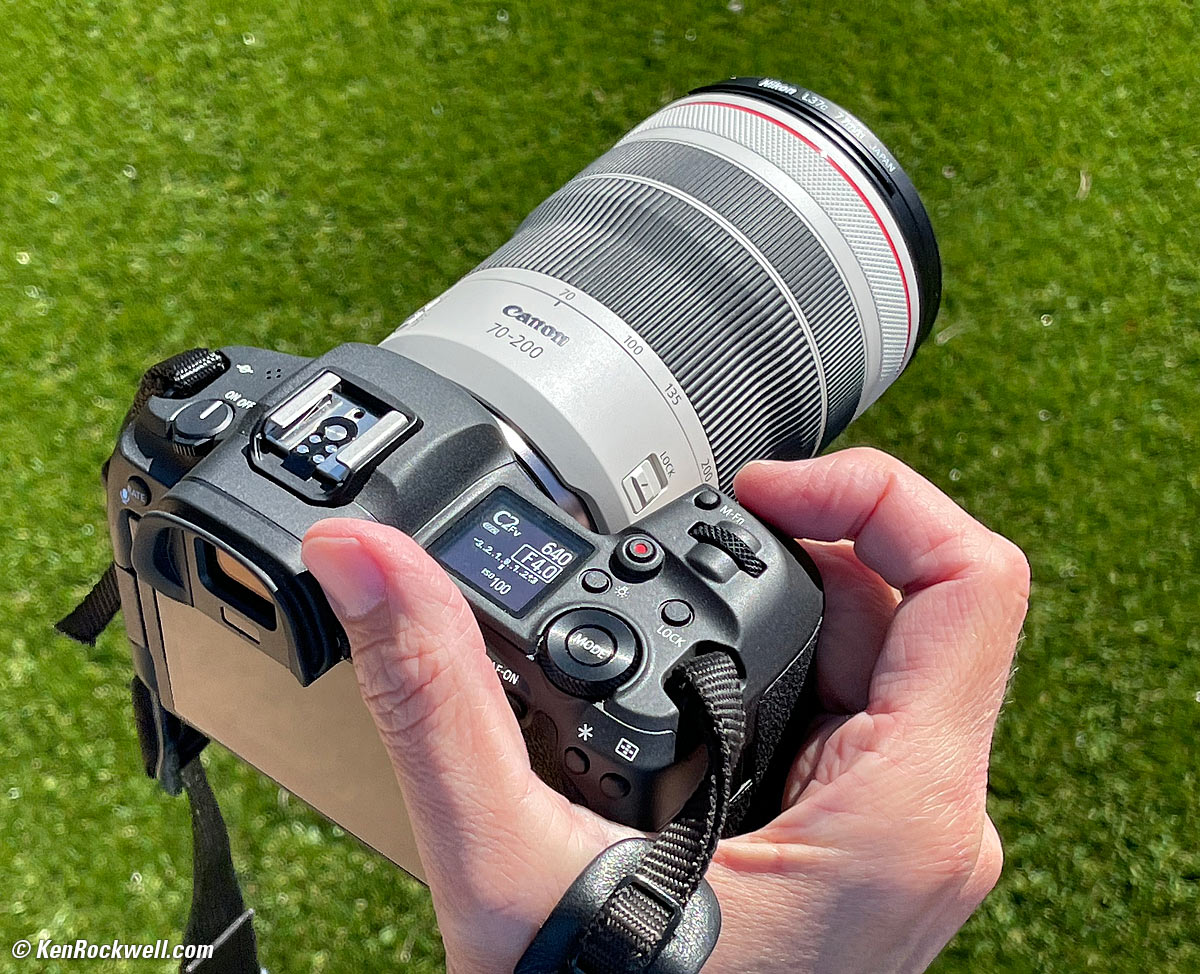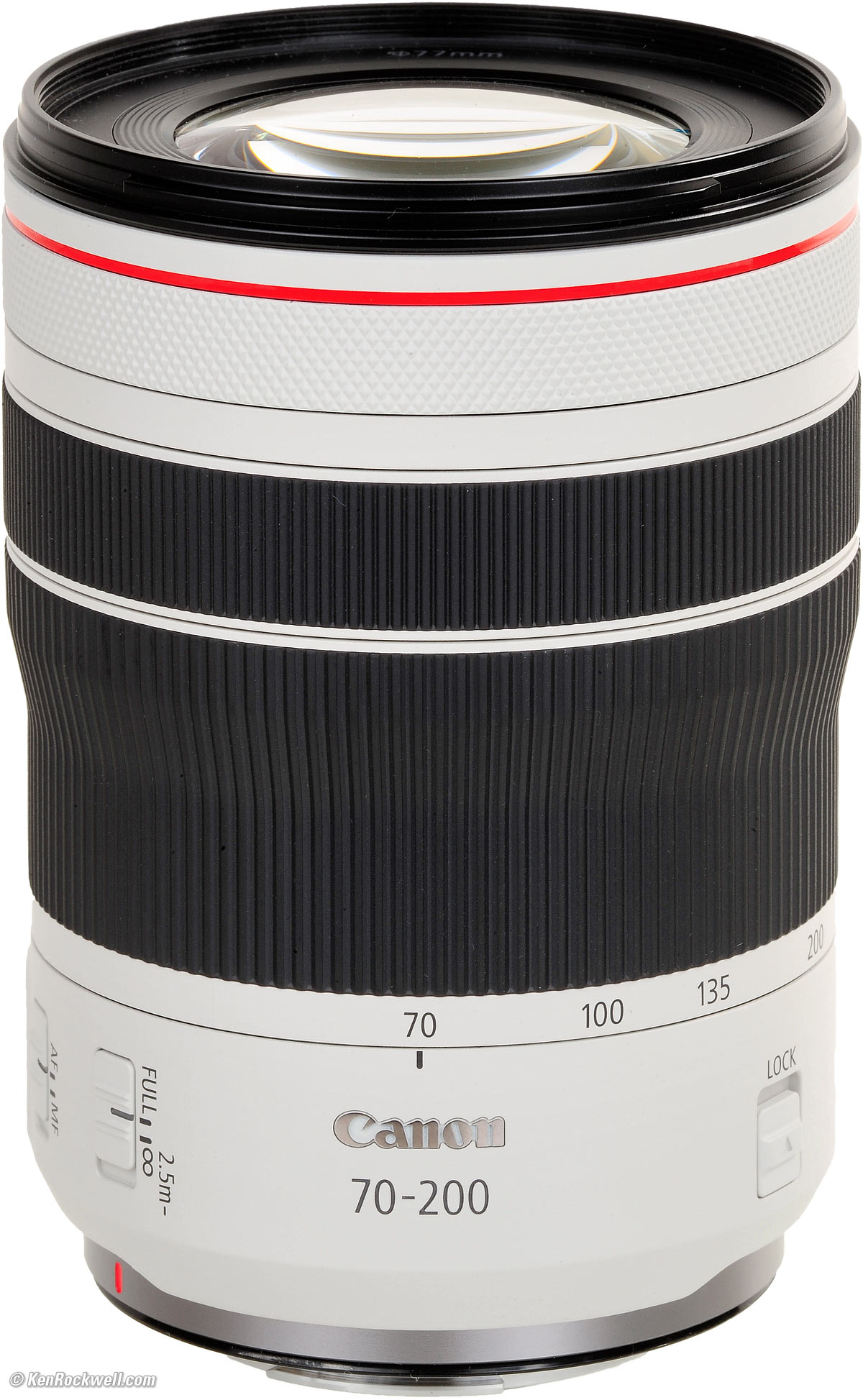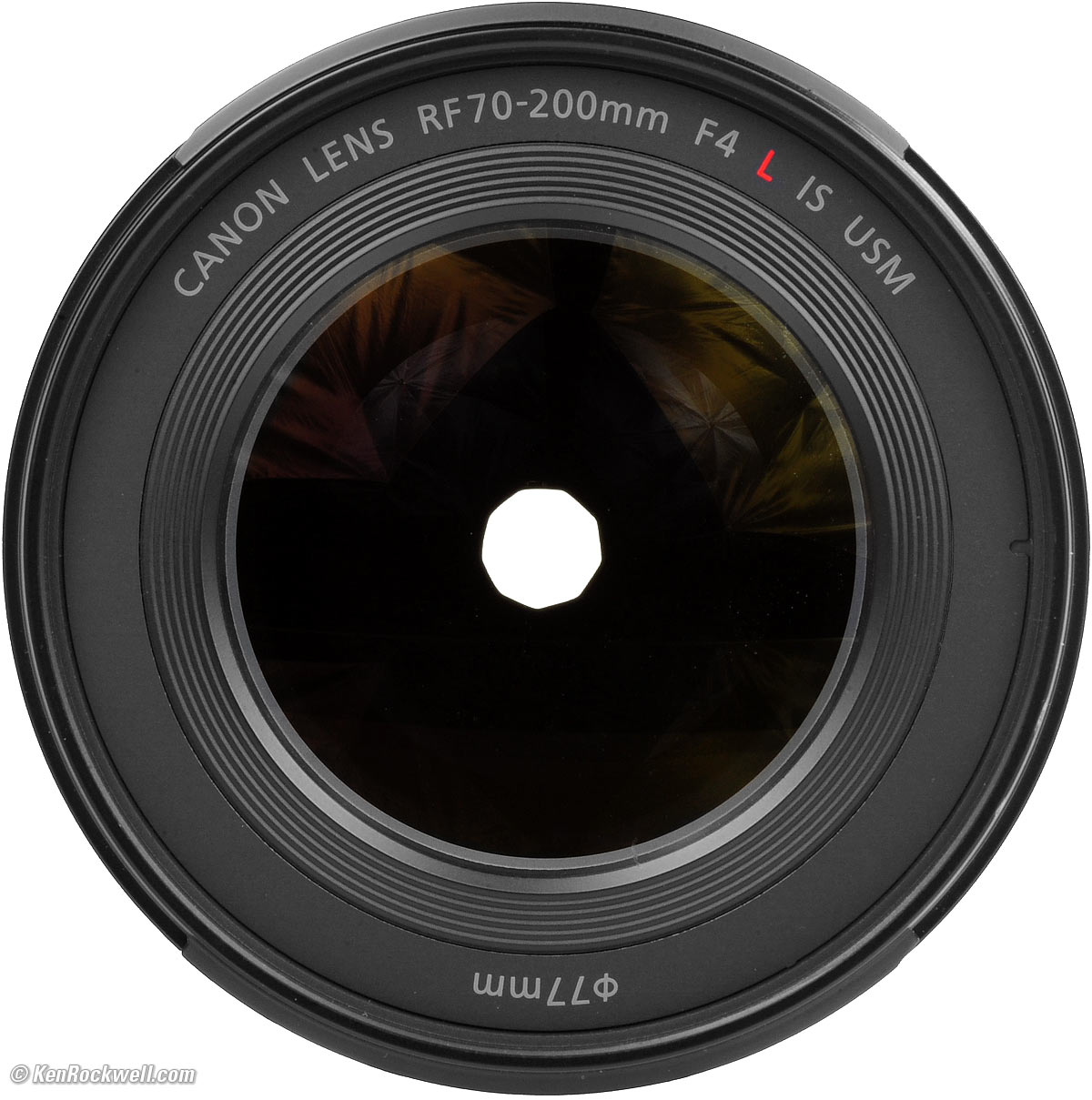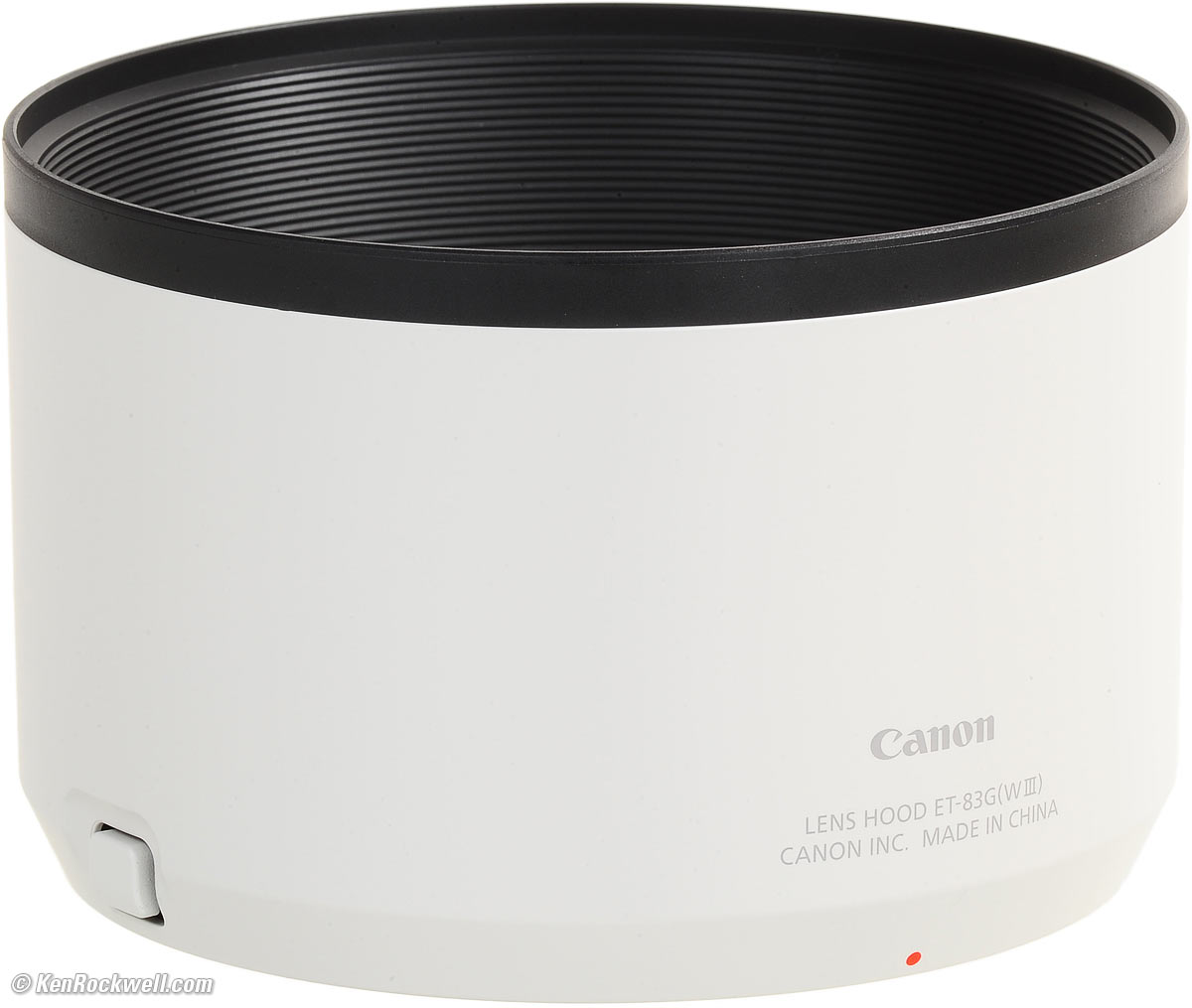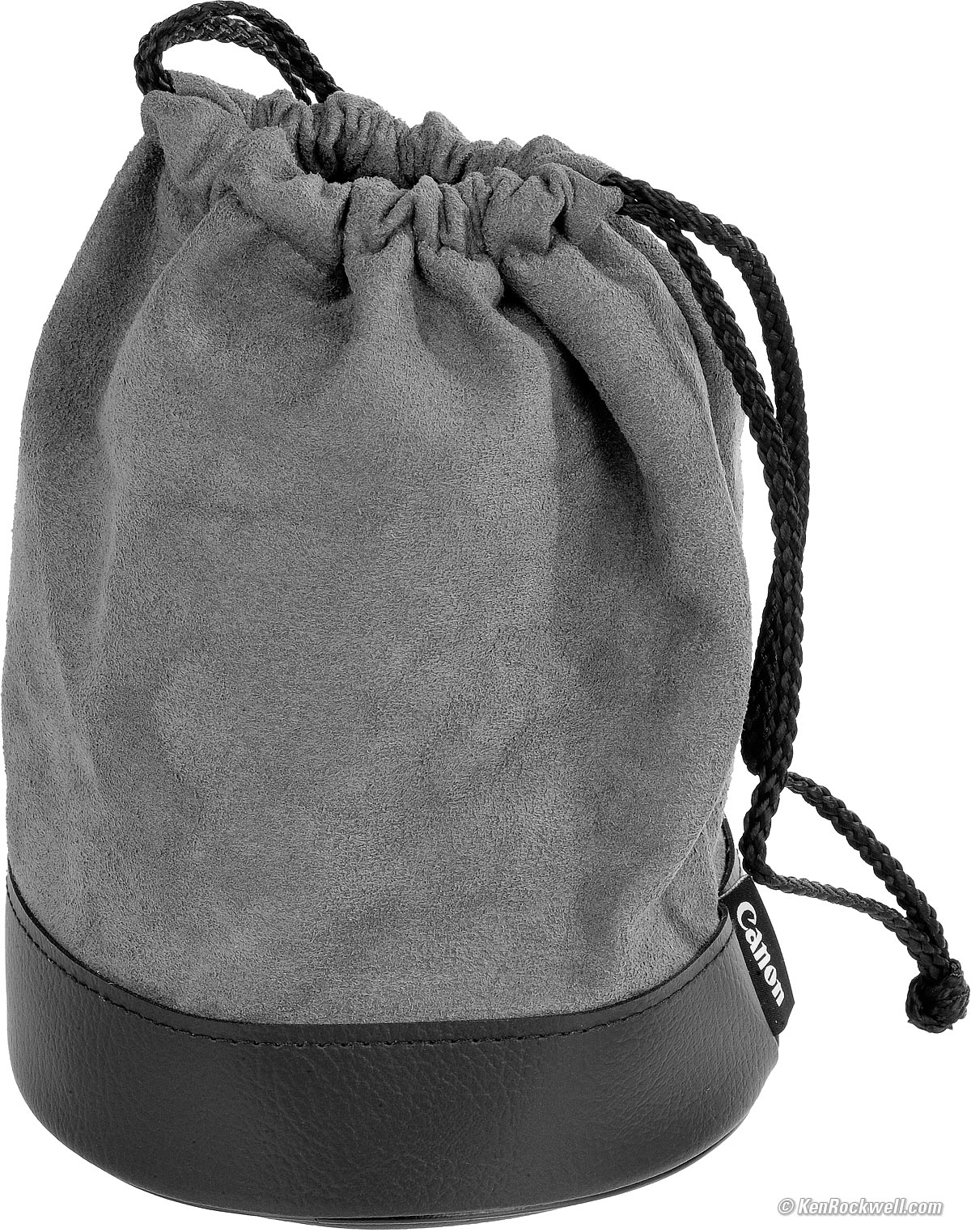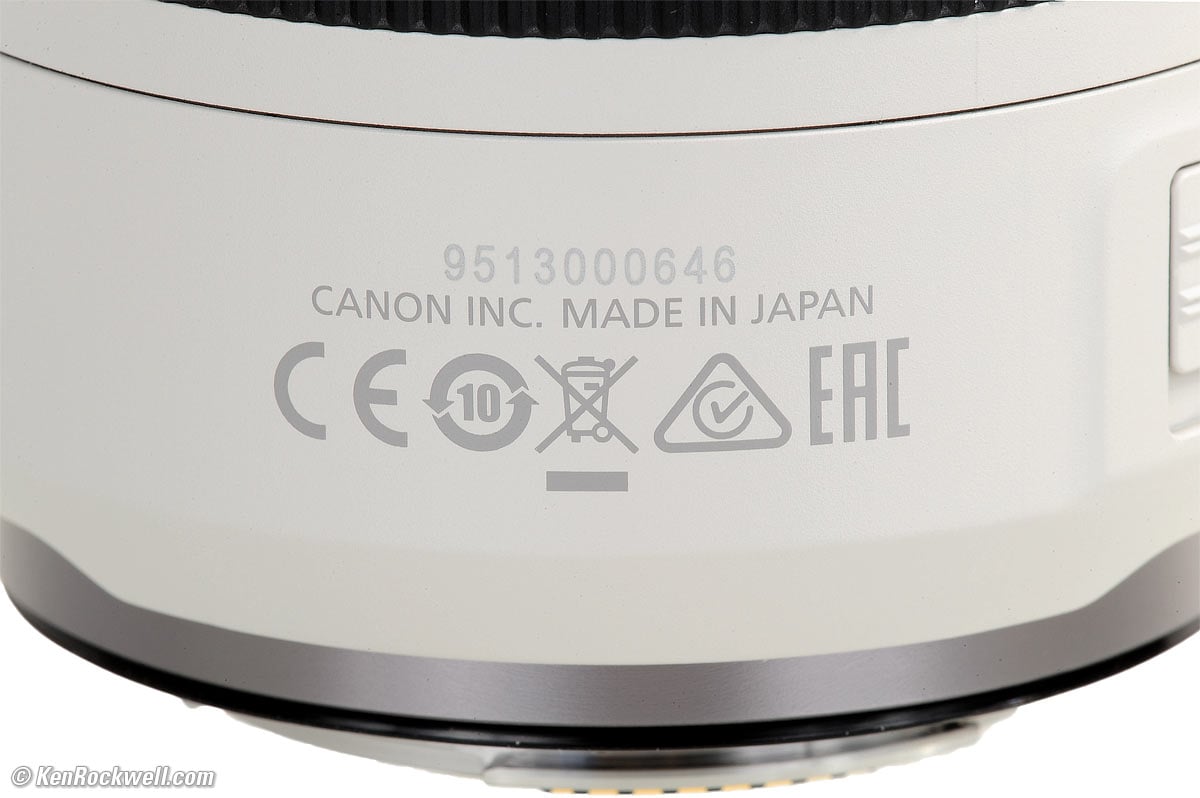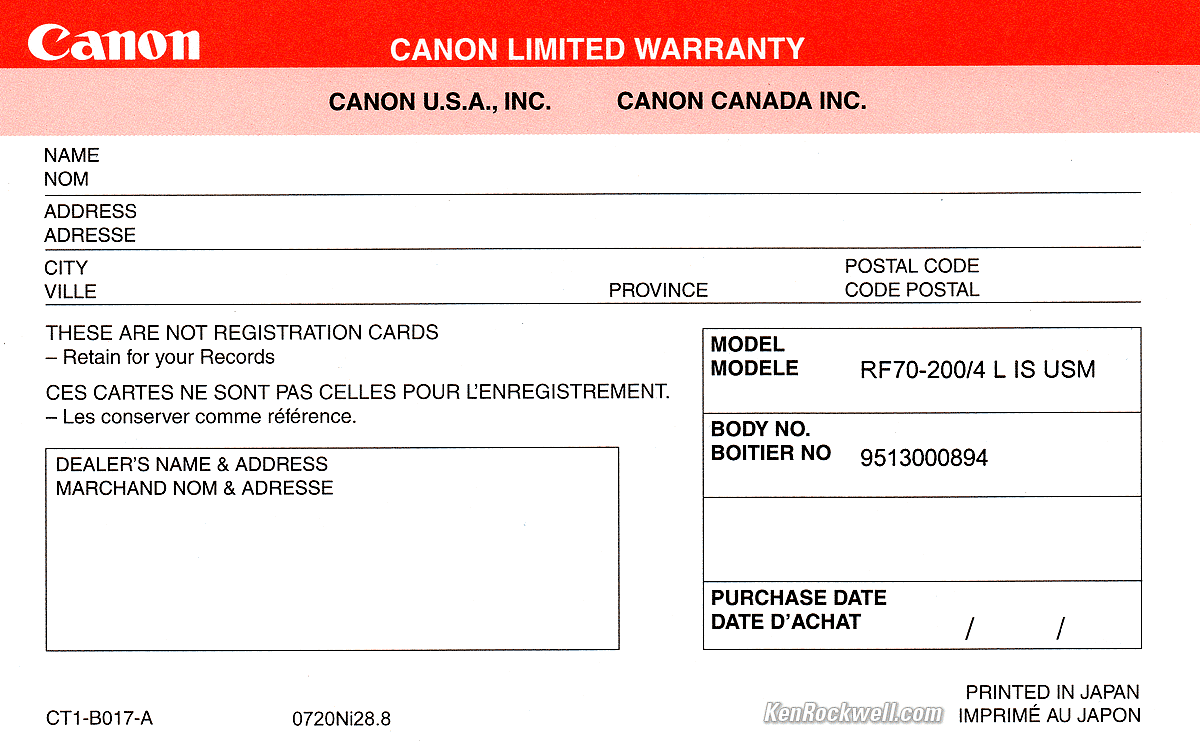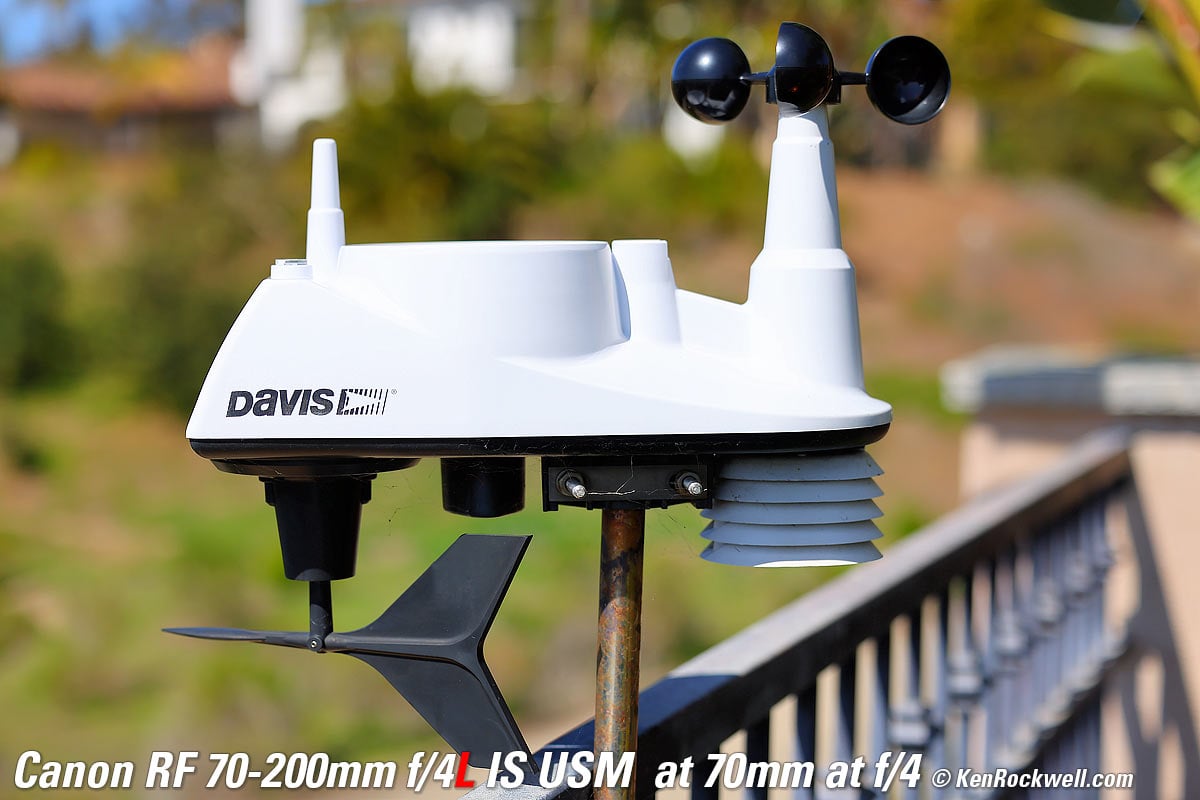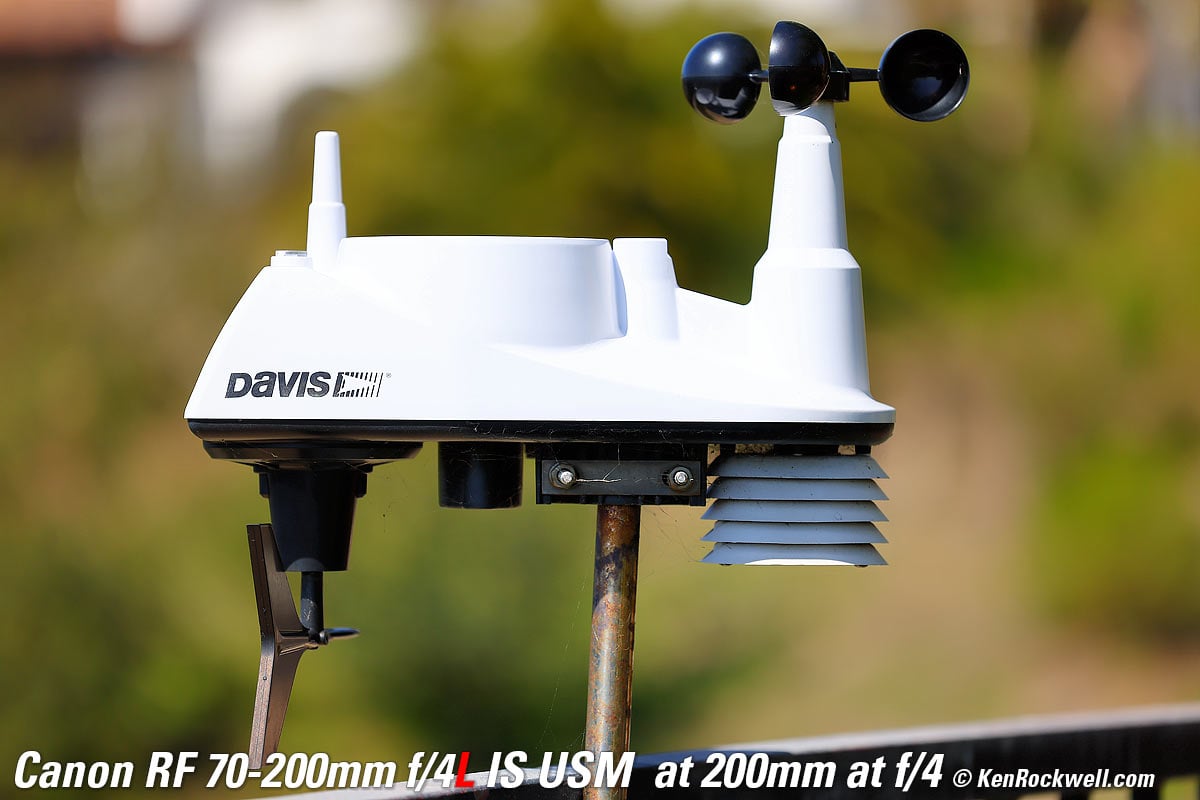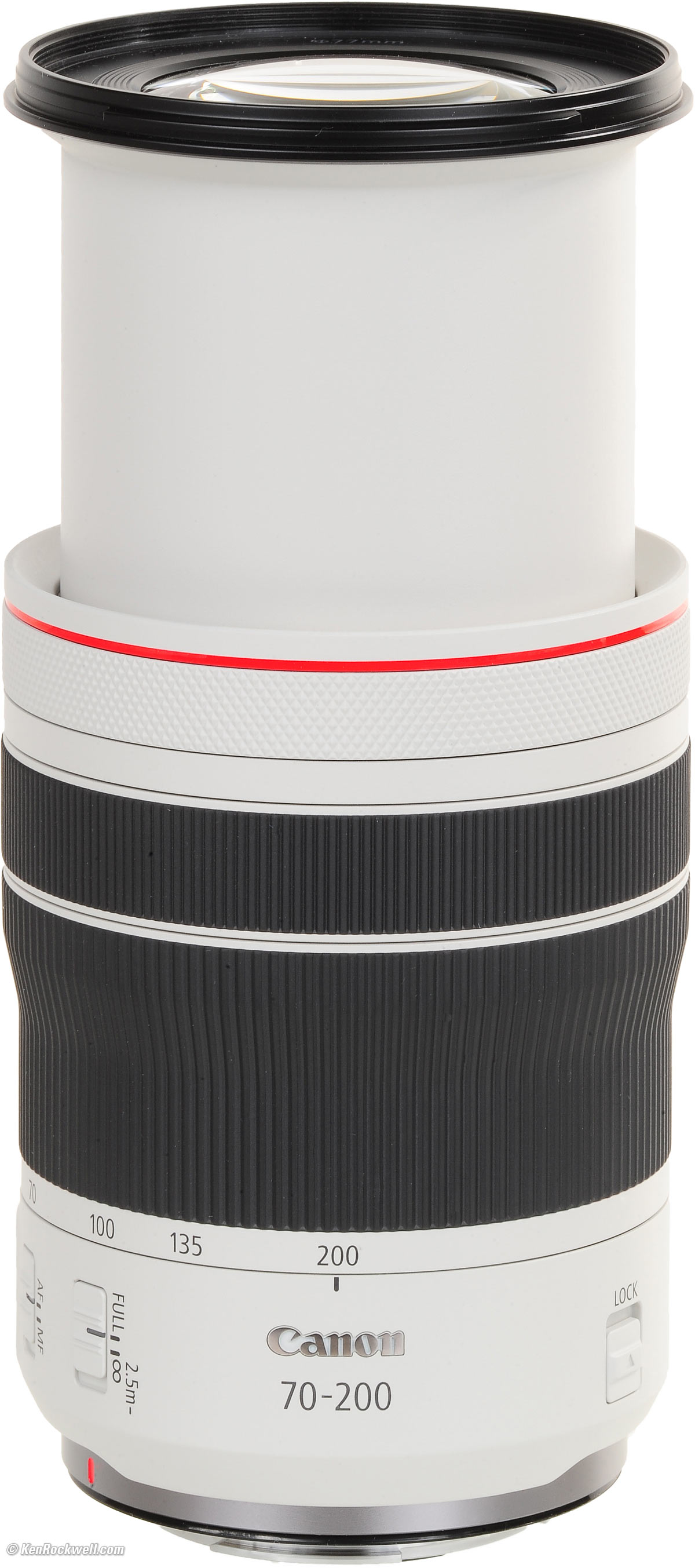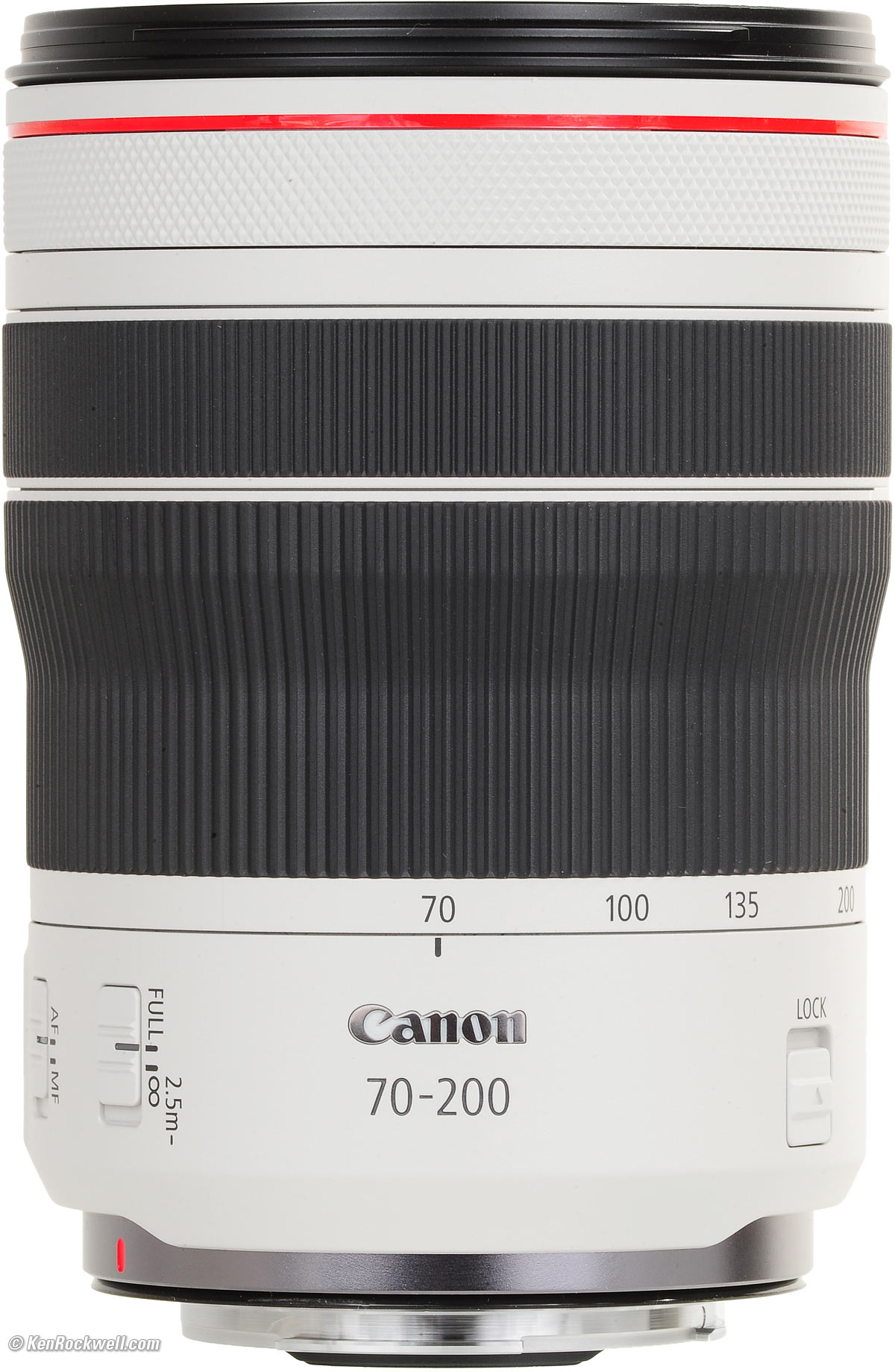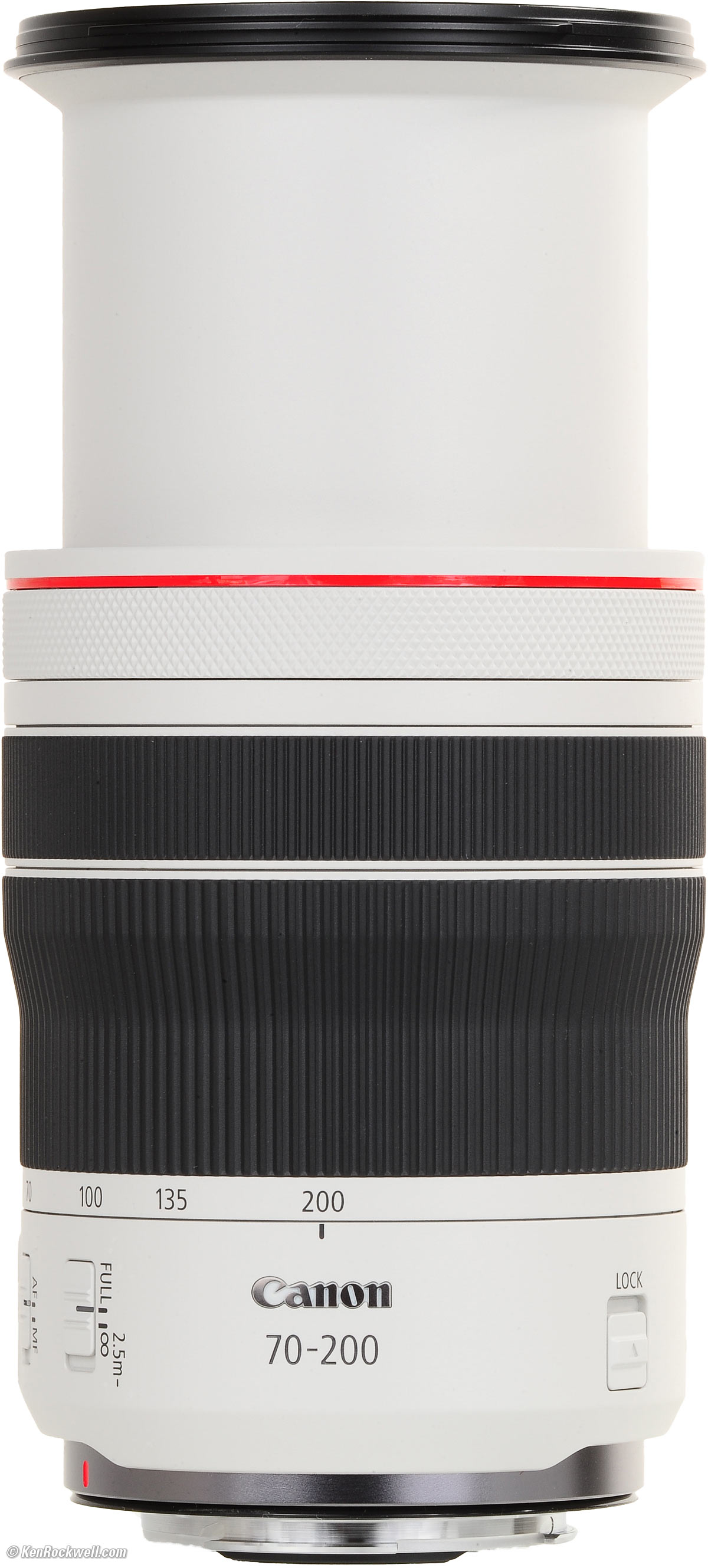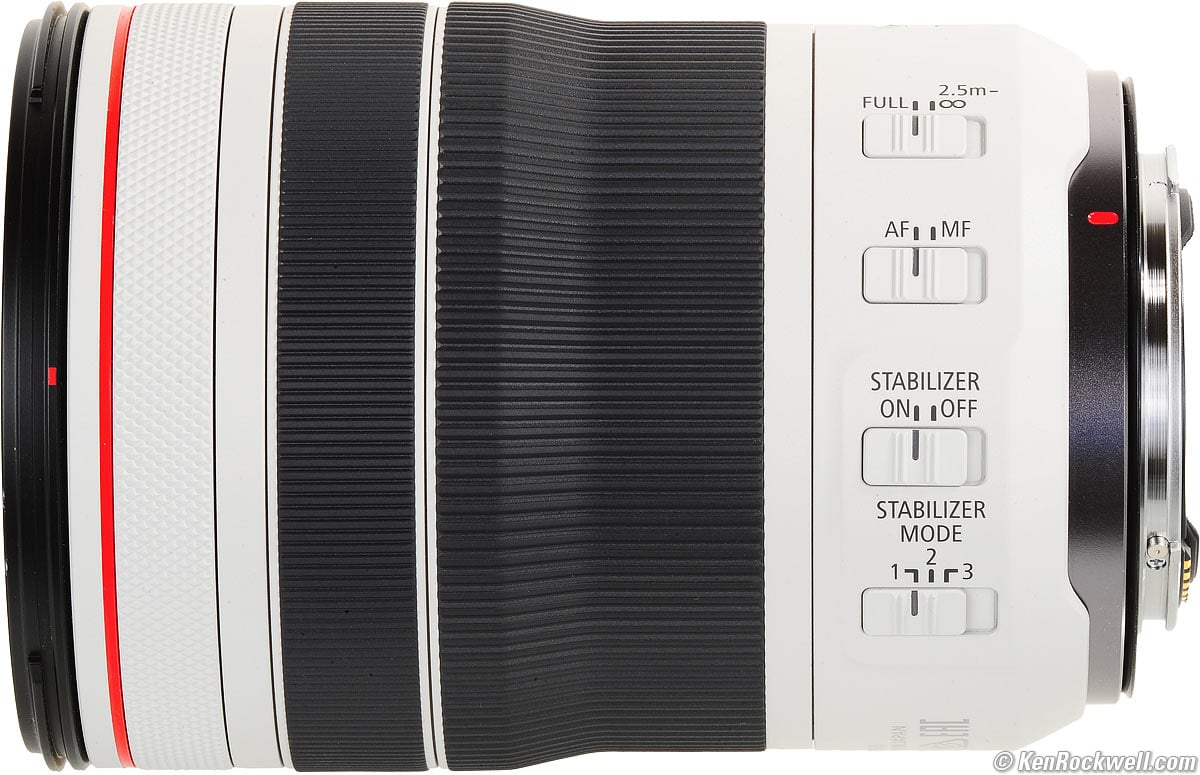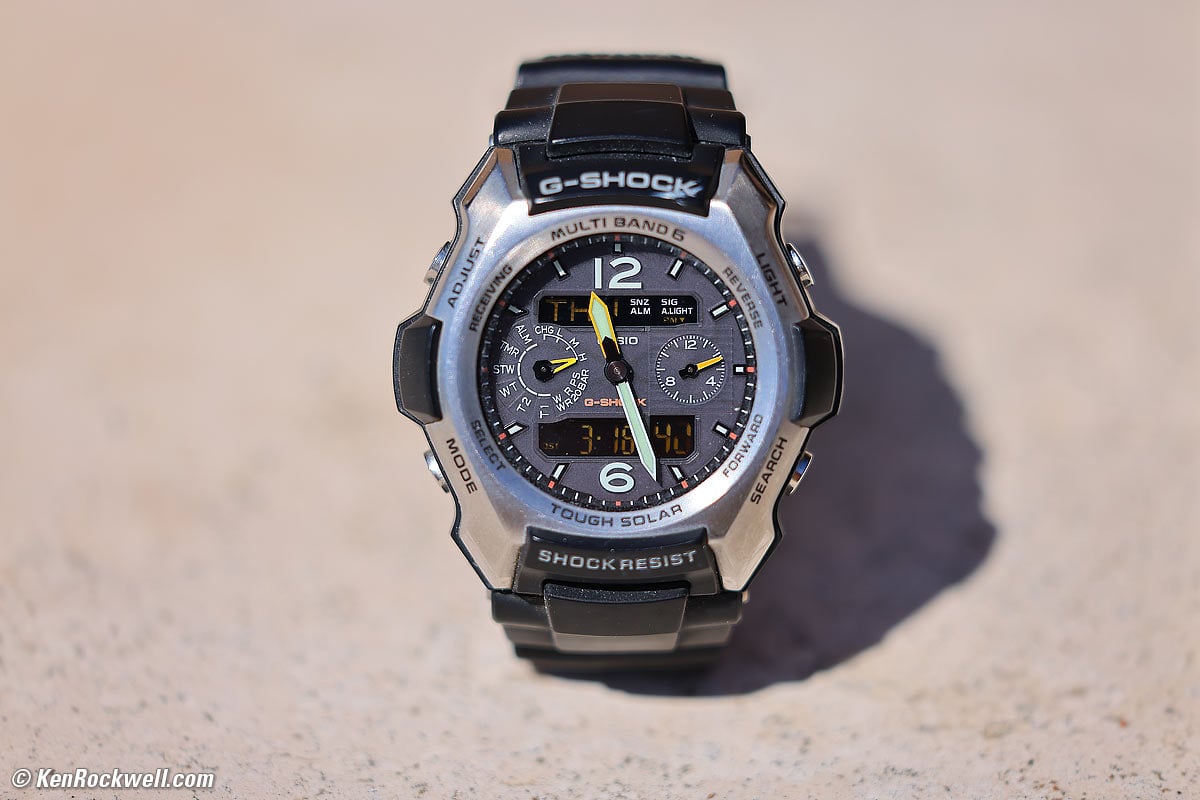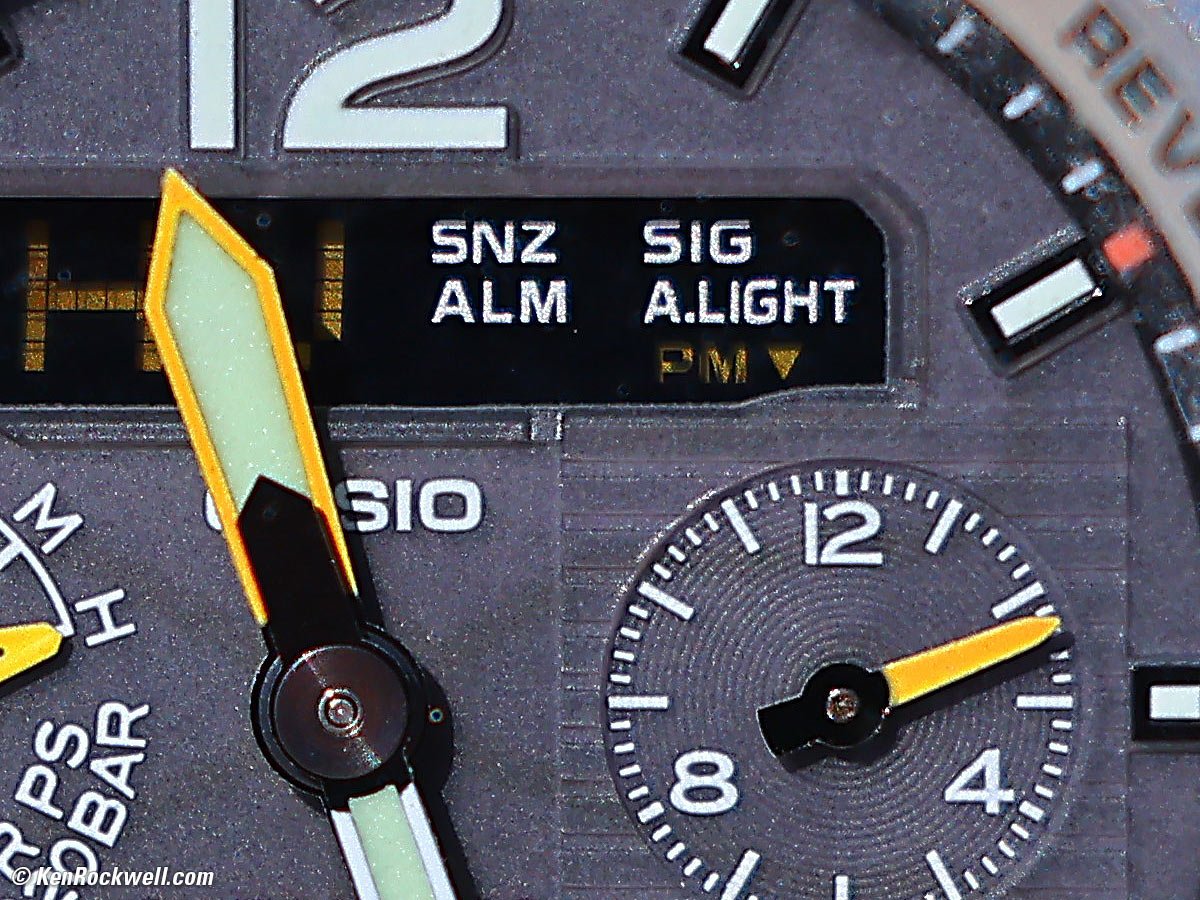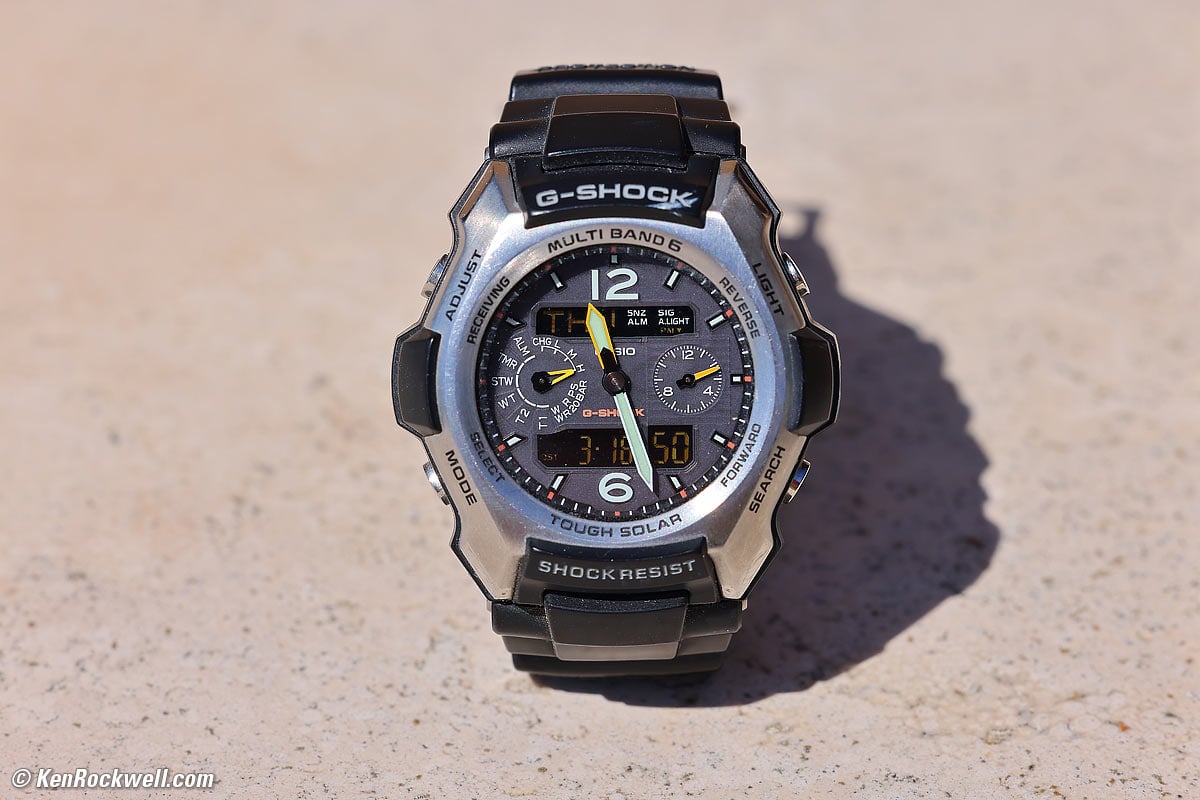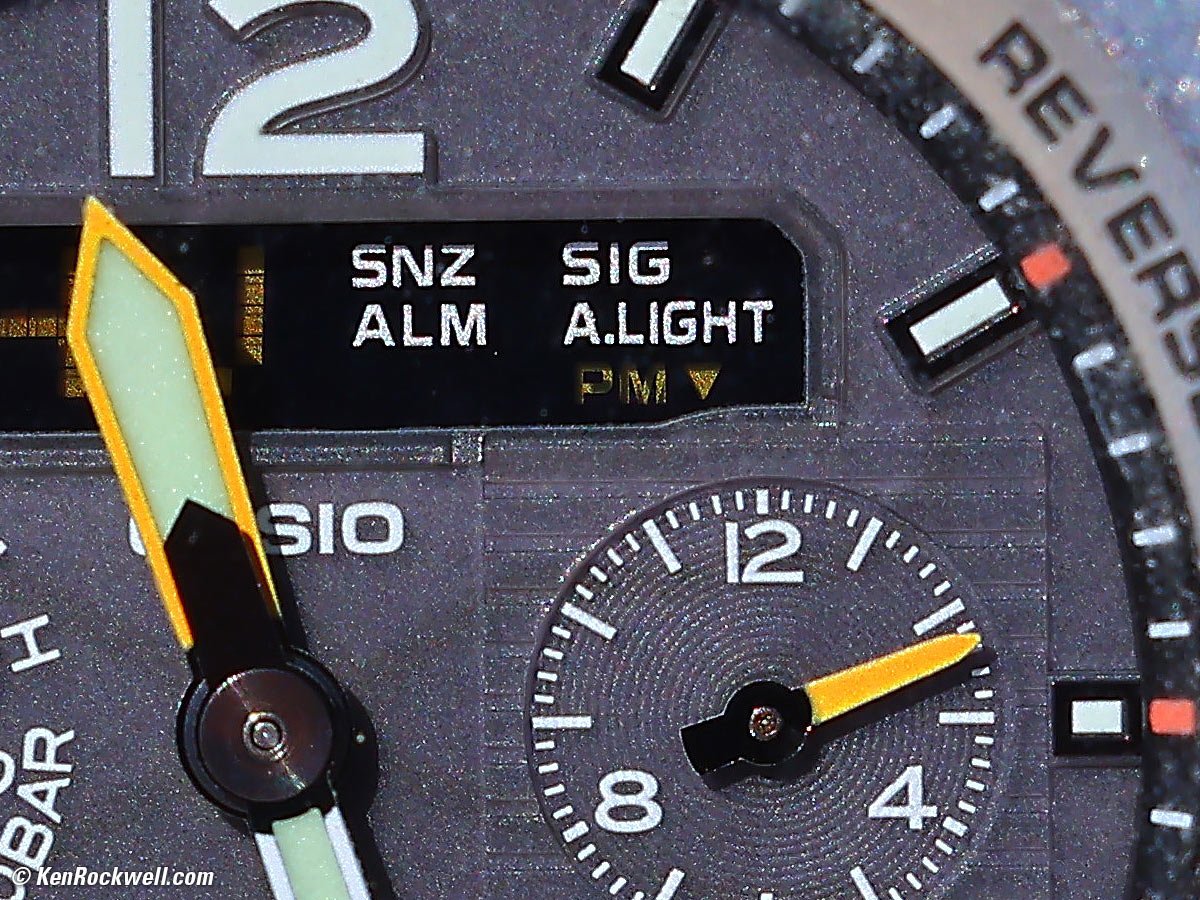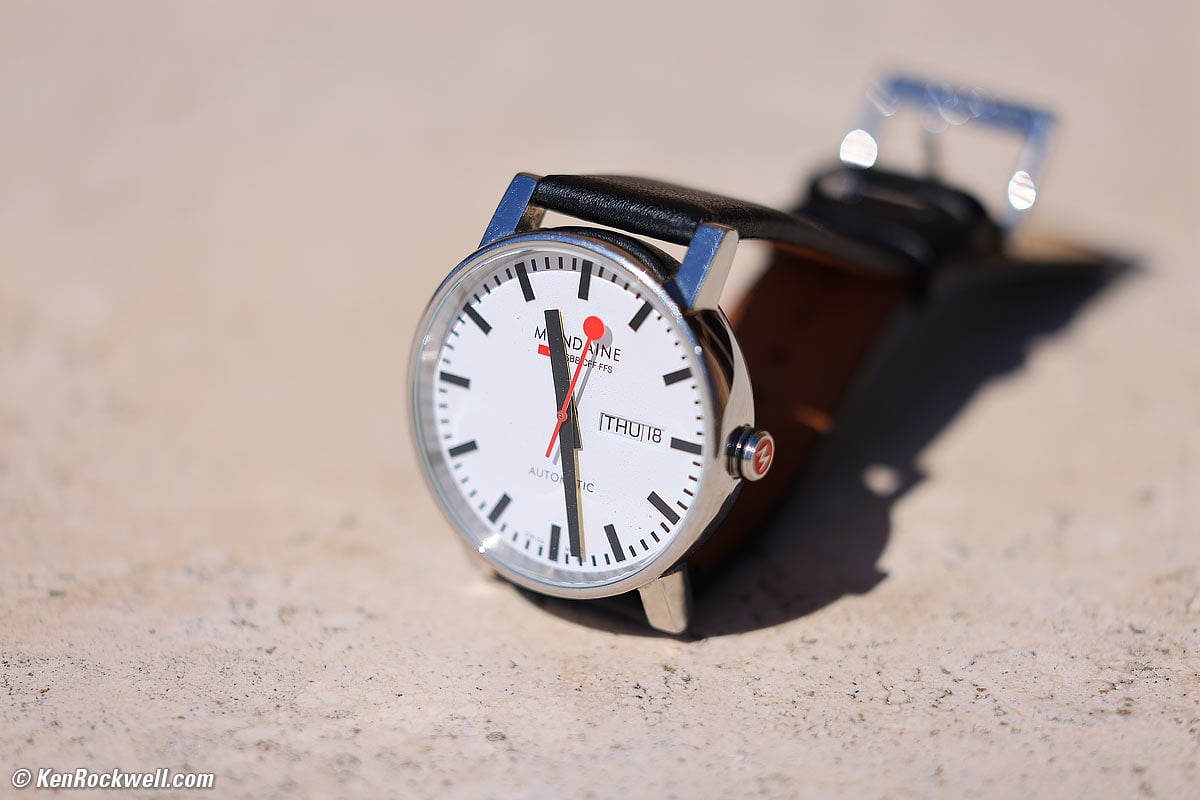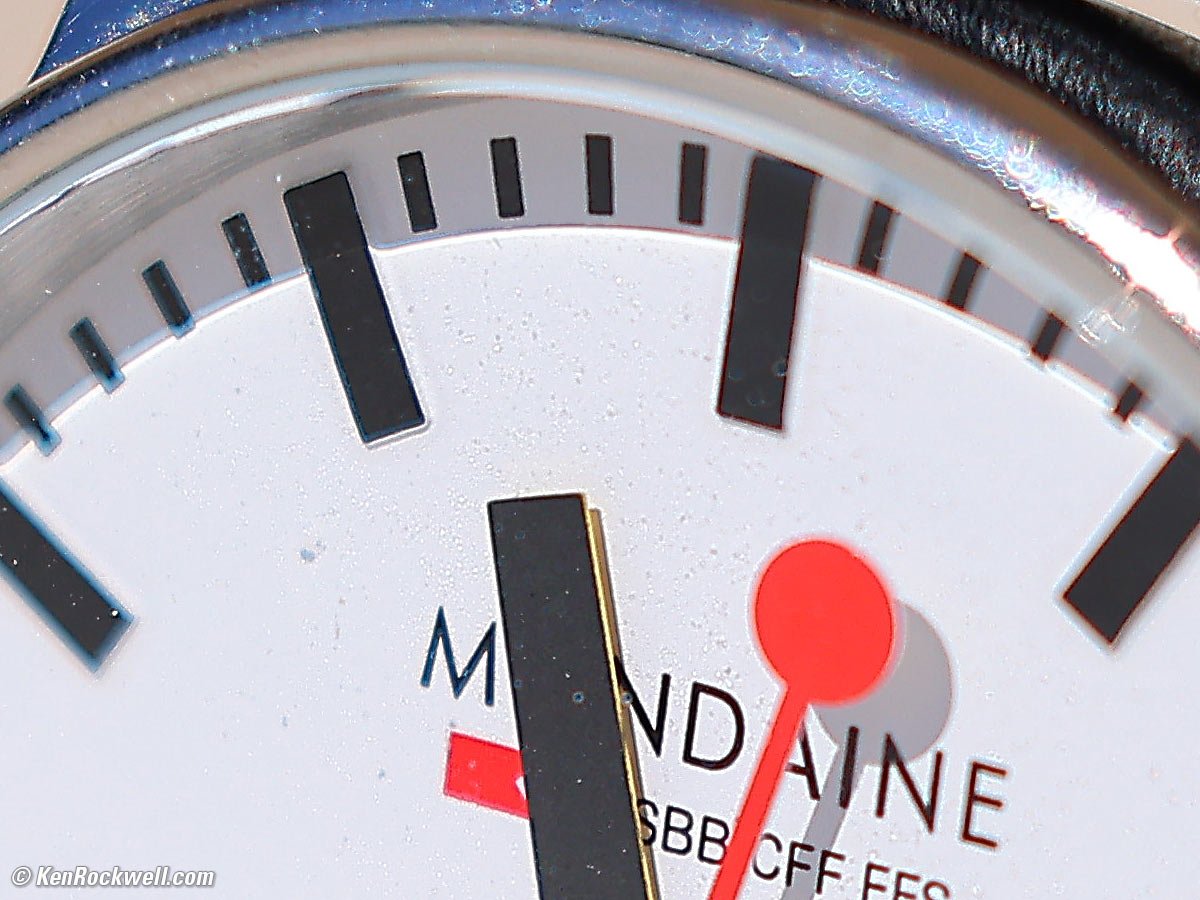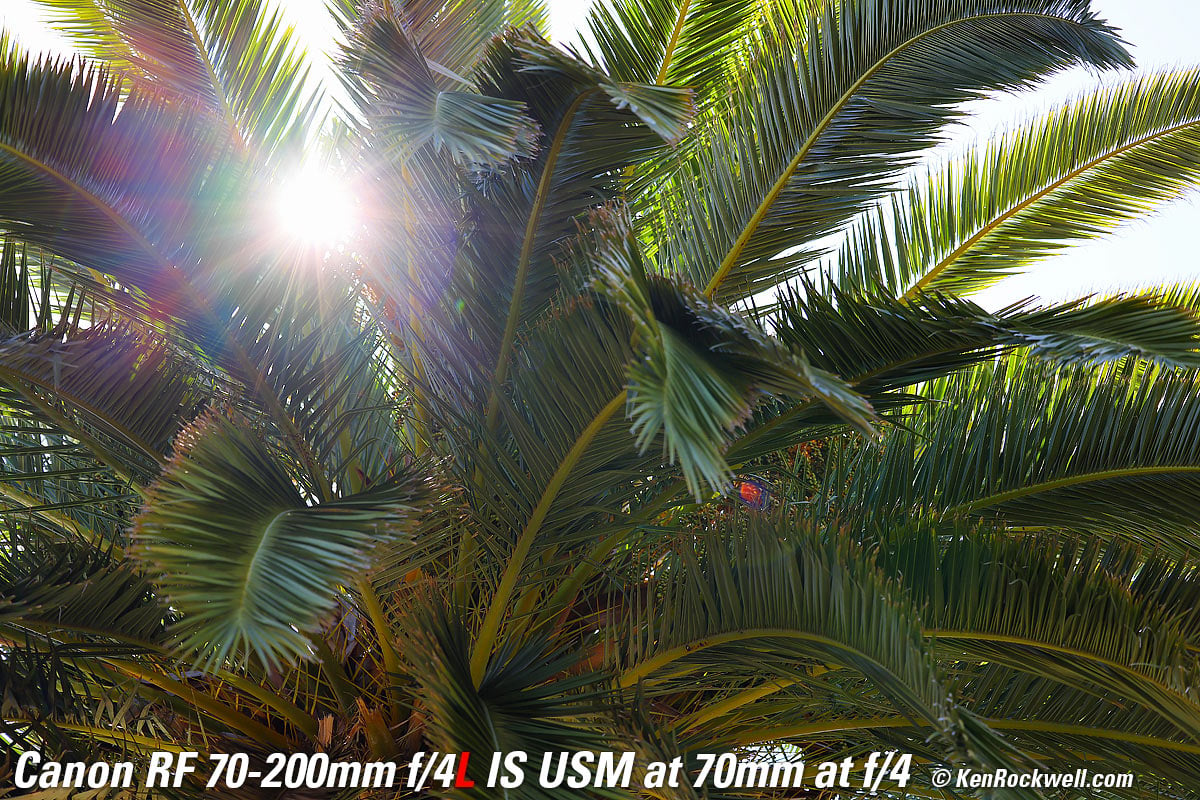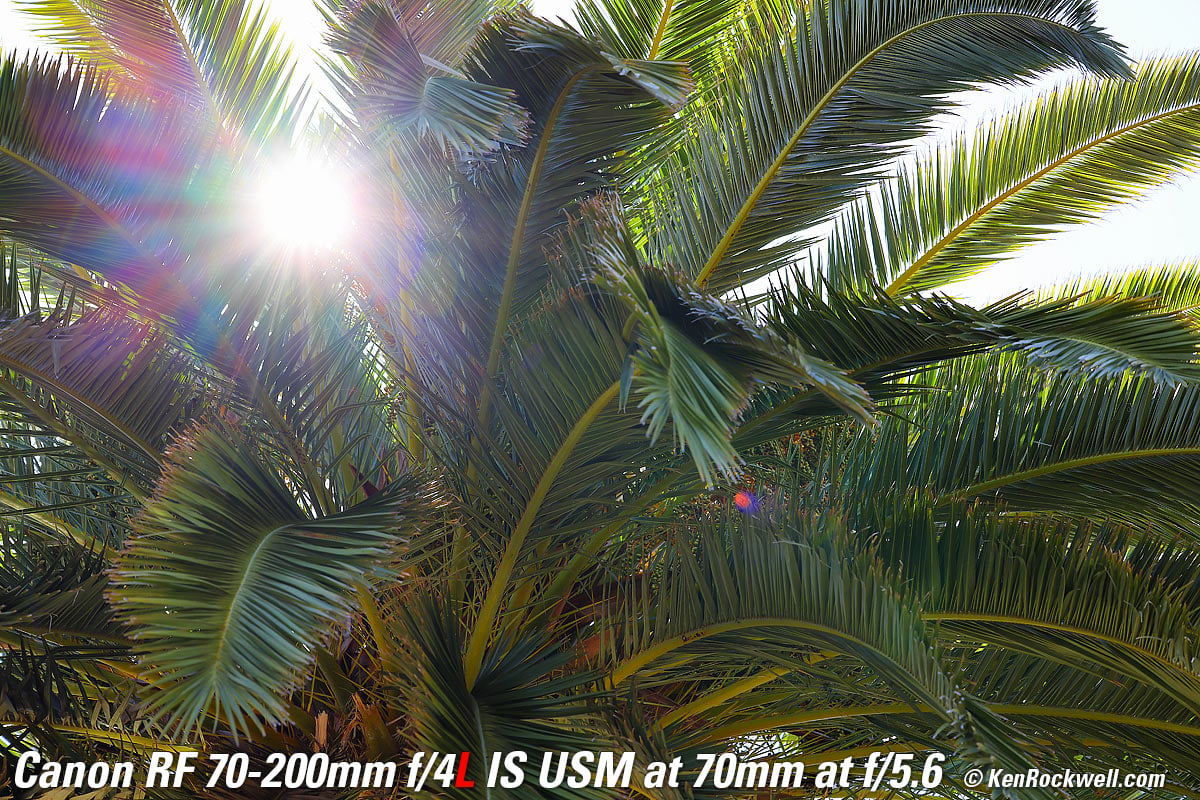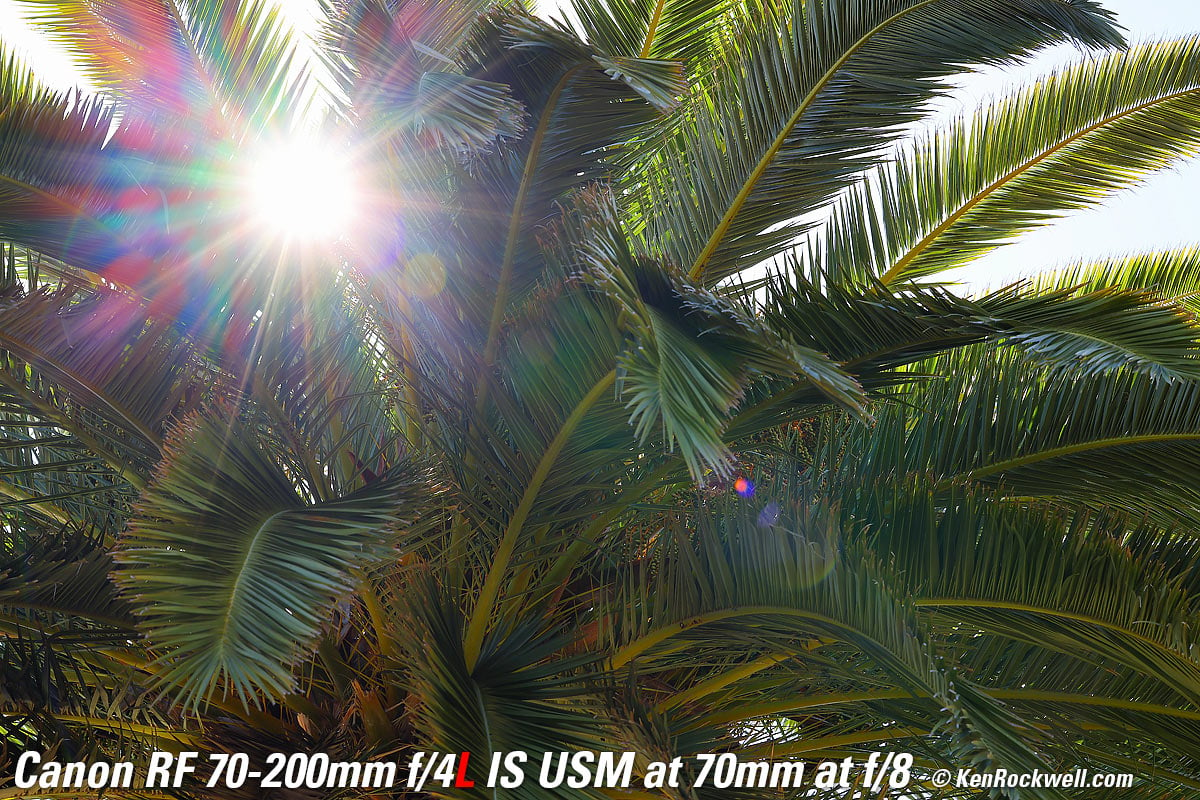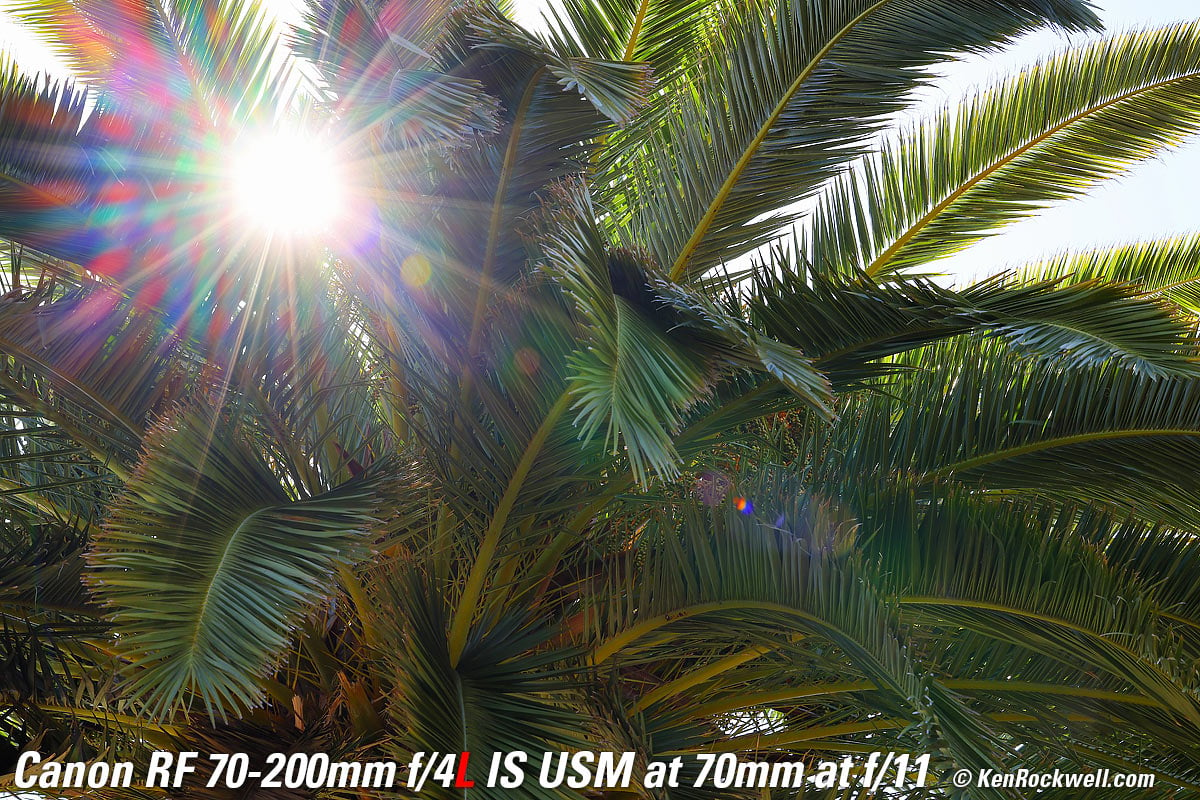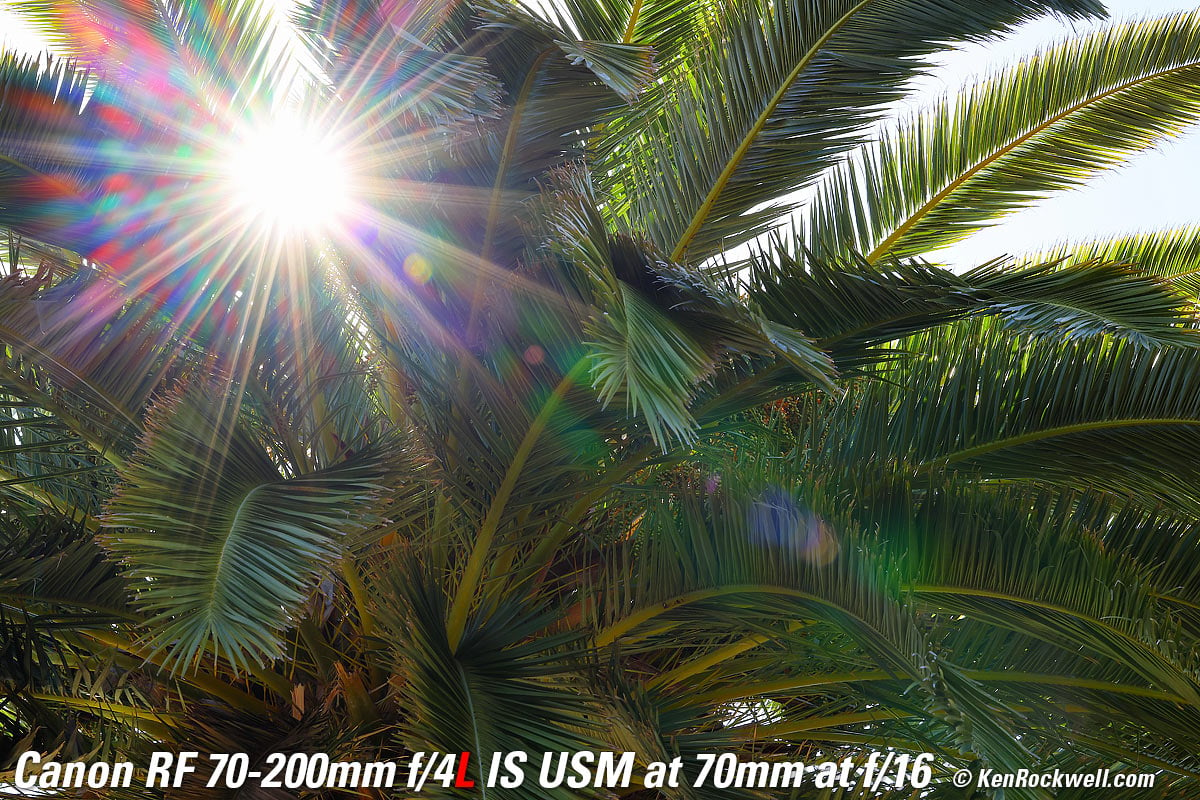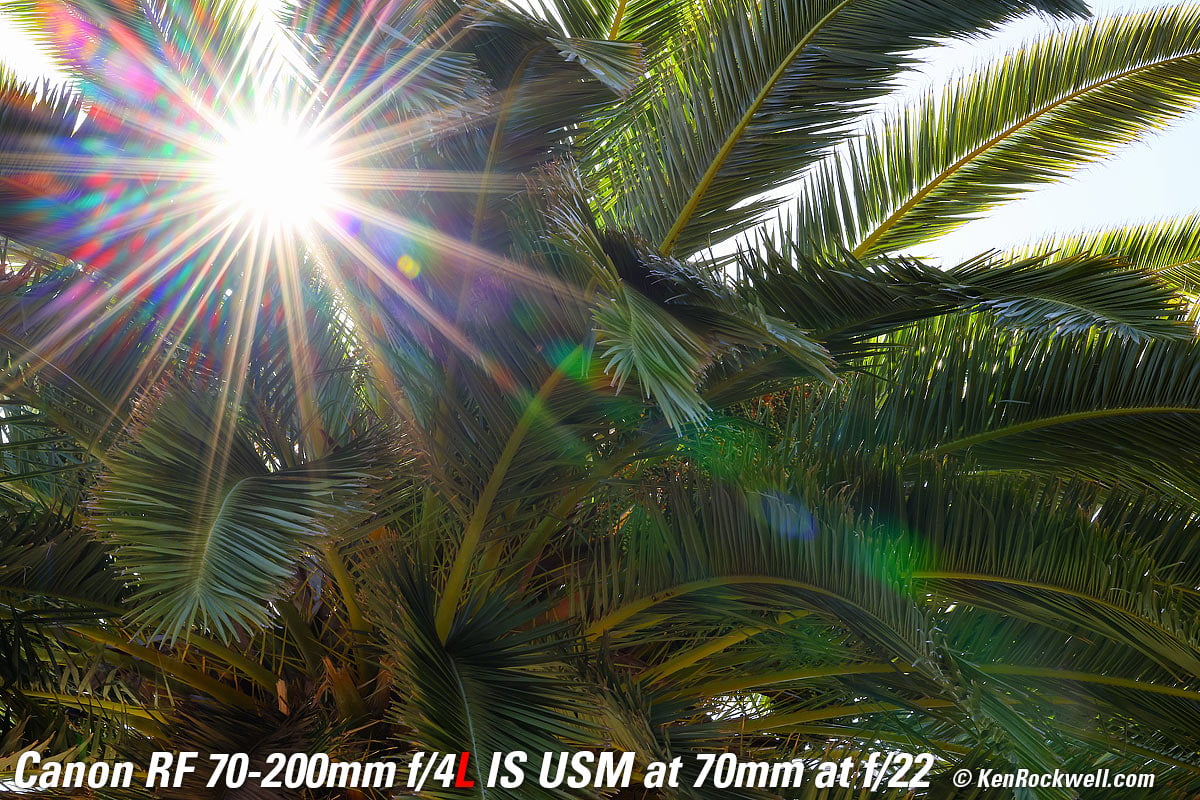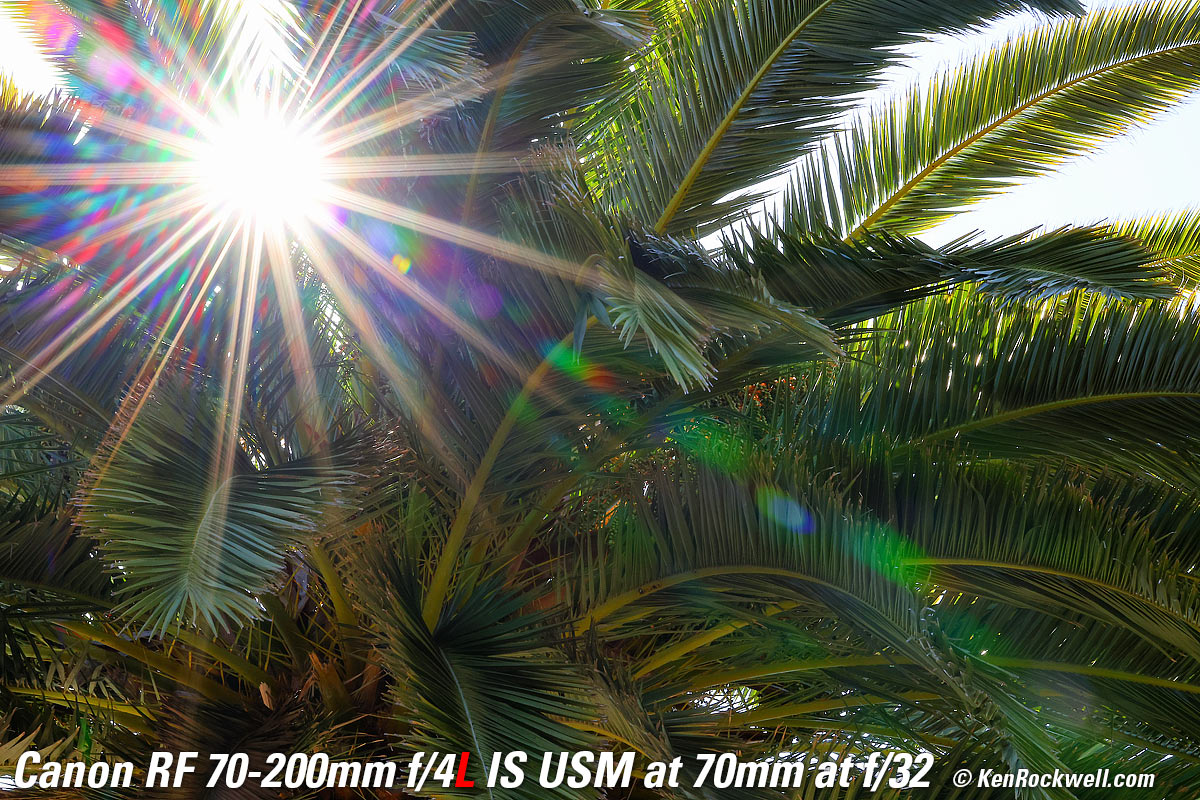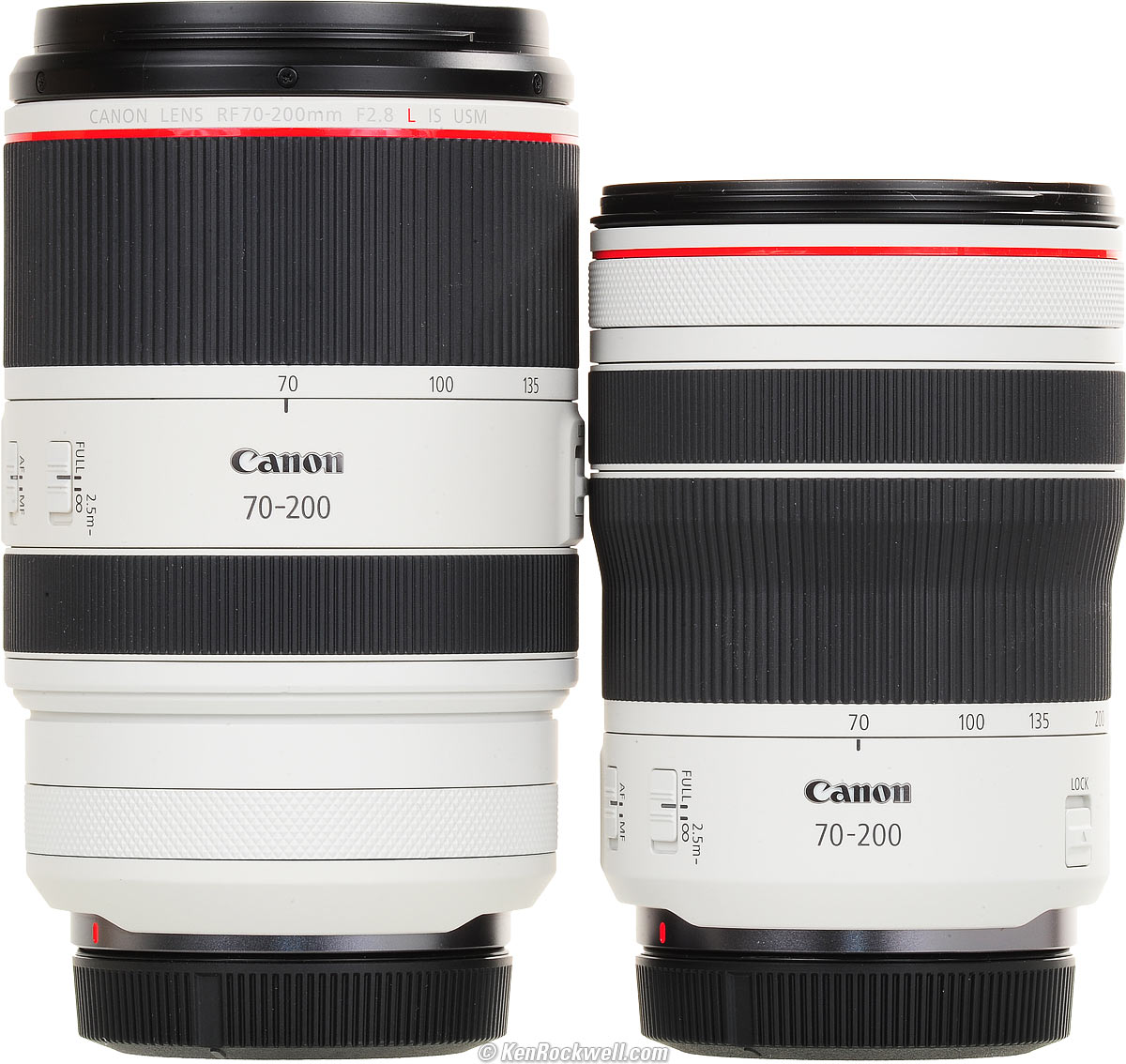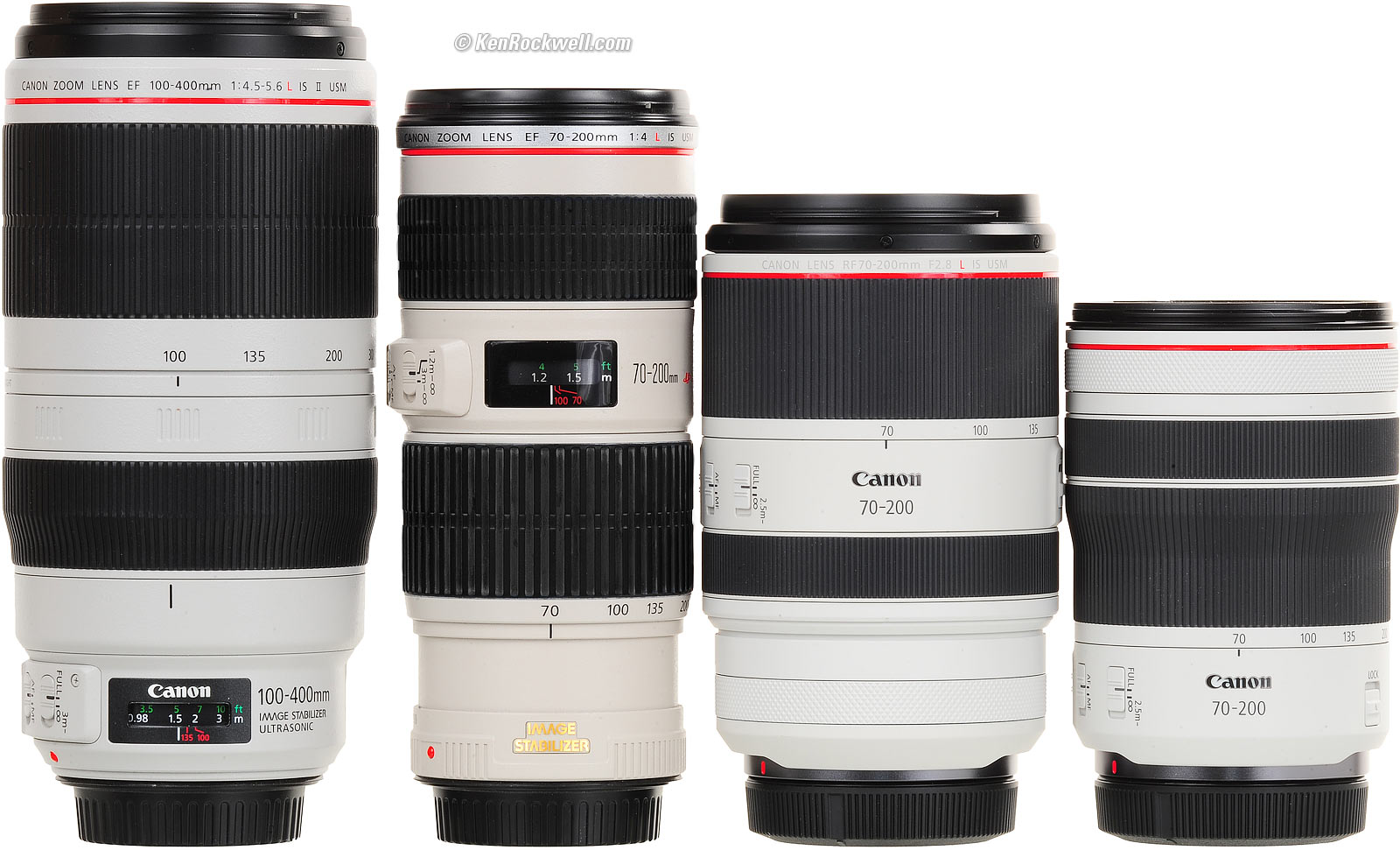Canon RF 70-200mm f/4L
Full Frame Mirrorless IS USM
Ultra-Fast Autofocus
World's closest-focussing 70-200mm at 200mm
World's Smallest & Lightest 70-200/4
Sample Images Introduction Compatibility
Specifications USA Version Performance
Compared User's Guide Recommendations
R3 R5 R5C R6 II R6 R R8 RP R7 R10 R50 R100
Bodies Compared RF Lenses EF Lenses Flash
Canon RF 70-200mm f/4L IS USM (77mm filters, 24.3 oz./688g, 2'/0.6m close focus, $1,499). bigger. I got mine at B&H. I'd also get mine at Adorama, at Amazon or at Crutchfield, or about $1,000 used if you know How to Win at eBay.
This 100% all-content, junk-free website's biggest source of support is when you use those or any of these links to my personally approved sources I've used myself for way over 100 combined years when you get anything, regardless of the country in which you live. Canon does not seal its boxes in any way, so never buy at retail or any other source not on my personally approved list since you'll have no way of knowing if you're missing accessories, getting a defective, damaged, returned, non-USA, store demo or used lens — and all of my personally approved sources allow for 100% cash-back returns for at least 30 days if you don't love your new lens. I've used many of these sources since the 1970s because I can try it in my own hands and return it if I don't love it, and because they ship from secure remote warehouses where no one gets to touch your new lens before you do. Buy only from the approved sources I've used myself for decades for the best prices, service, return policies and selection.
April 2024 Better Pictures Canon Reviews Mirrorless RF Lenses EF Lenses Flash All Reviews
Sample Images top
Sample Images Introduction Compatibility
Specifications USA Version Performance
Compared User's Guide Recommendations
More samples at Bokeh, Macro, Sharpness, Spherochromatism and Sunstars.
These are just snapshots; my real work is in my Gallery.
These are all shot hand-held as NORMAL JPGs; no tripods, FINE JPGs or RAW CR3 files were used or needed.
Furry Plants, Palms, Mountains and Storm Clouds, 12:34 PM, 11 March 2021. Canon EOS R5, Canon RF 70-200mm f/4 L IS at 176 mm at f/13 hand-held at 1/200 at Auto ISO 160 (LV 14⅓), Perfectly Clear. bigger or camera-original 45MP © JPG file (14 MB).
Palms at Last Light Against Storm Clouds, 5:02 PM, 11 March 2021. Canon EOS R5, Canon RF 70-200mm f/4 L IS at 95 mm at f/8 hand-held at 1/200 at Auto ISO 100 (LV 13⅔), exactly as shot. bigger or camera-original 45MP © JPG file (10 MB).
Fine Homes, Palms, Mountains and Storm Clouds, 5:03 PM, 11 March 2021. Canon EOS R5, Canon RF 70-200mm f/4 L IS at 105 mm at f/7.1 hand-held at 1/250 at Auto ISO 100 (LV 13⅔), Perfectly Clear. bigger or camera-original 45MP © JPG file (10 MB).
Introduction top
Sample Images Introduction Compatibility
Specifications USA Version Performance
Compared User's Guide Recommendations
|
I buy only from these approved sources. I can't vouch for ads below. |
This is an ultra-sharp and ultra-ultra compact professional telephoto zoom for Canon's EOS-R mirrorless system. On my EOS R5, autofocus is faster than my own eyes!
Fulfilling the dream of mirrorless and quite different from Sony's huge, fat and bloated 70-200/2.8 GM, this Canon RF 70-200/4 is much smaller and lighter than any other 70-200mm, ever. It's about half the length of other 70-200/4s. It's the lightest 70-200mm ever made and focuses closer than any other 70-200mm at the long end. BRAVO!
It's so light that it's trivial to shoot with one hand:
Canon RF 70-200mm f/4L on EOS R5. bigger.
Canon RF 70-200mm f/4L IS. bigger.
I got my RF 70-200/4L IS at B&H. I'd also get mine at Adorama, at Amazon or at Crutchfield, or used at eBay if you know How to Win at eBay.
New intro top
 Smaller, lighter and closer-focussing version of the Canon RF 70-200/2.8 L IS, which had been the smallest, lightest and closest-focussing 70-200 for two years.
Smaller, lighter and closer-focussing version of the Canon RF 70-200/2.8 L IS, which had been the smallest, lightest and closest-focussing 70-200 for two years.
 Smallest, lightest and closest-focussing 70-200mm ever. (Huge Nikon Z 70-200/2.8 can focus closer at 70mm, but not as close at 200mm where we need it.)
Smallest, lightest and closest-focussing 70-200mm ever. (Huge Nikon Z 70-200/2.8 can focus closer at 70mm, but not as close at 200mm where we need it.)
Good intro top
 Ultra sharp.
Ultra sharp.
 Super close focussing: the world's closest for a 70-200 at 200mm!
Super close focussing: the world's closest for a 70-200 at 200mm!
 Ultra fast autofocusing on the EOS R5 (faster than my own eyes), and fast even on the EOS RP.
Ultra fast autofocusing on the EOS R5 (faster than my own eyes), and fast even on the EOS RP.
 Smallest 70-200 ever.
Smallest 70-200 ever.
 Lightest 70-200 ever.
Lightest 70-200 ever.
 Great sunstars.
Great sunstars.
 Stops down to f/32.
Stops down to f/32.
 Fluorine coating to resist dirt and crud.
Fluorine coating to resist dirt and crud.
 Programmable third control ring.
Programmable third control ring.
 Image Stabilization claims 5 stops improvement, and 7.5 stops when used on the R5 or R6.
Image Stabilization claims 5 stops improvement, and 7.5 stops when used on the R5 or R6.
 Includes a great hood.
Includes a great hood.
 Includes a carry sack.
Includes a carry sack.
 Made in Japan.
Made in Japan.
 100% U.S.A.-based high-quality technical support at (800) OK-CANON.
100% U.S.A.-based high-quality technical support at (800) OK-CANON.
Bad intro top
Missing intro top
 No always-responsive instant manual-focus override. EOS R cameras need a menu setting changed for manual-focus override, otherwise the focus ring is always ignored in AF. Find the "Lens electronic AF" option in your AF menu (AF 4 in EOS R5 or CAMERA 8 in EOS RP), and set it to either "One‑Shot‑>enabled" or "One‑Shot‑>enabled (magnify)." Now manual focus override works if you turn the ring while continuing to hold the shutter halfway, but only after focus locks in ONE SHOT.
No always-responsive instant manual-focus override. EOS R cameras need a menu setting changed for manual-focus override, otherwise the focus ring is always ignored in AF. Find the "Lens electronic AF" option in your AF menu (AF 4 in EOS R5 or CAMERA 8 in EOS RP), and set it to either "One‑Shot‑>enabled" or "One‑Shot‑>enabled (magnify)." Now manual focus override works if you turn the ring while continuing to hold the shutter halfway, but only after focus locks in ONE SHOT.
 No focus lock buttons; program one on the camera if you prefer.
No focus lock buttons; program one on the camera if you prefer.
 Nothing else missing, other than a lot of bulk and weight. Comes with a carry sack and a great hood — not that I ever use hoods.
Nothing else missing, other than a lot of bulk and weight. Comes with a carry sack and a great hood — not that I ever use hoods.
Compatibility top
Sample Images Introduction Compatibility
Specifications USA Version Performance
Compared User's Guide Recommendations
I got my RF 70-200/4L IS at B&H. I'd also get mine at Adorama, at Amazon or at Crutchfield, or used at eBay if you know How to Win at eBay.
This lens only works on Canon's EOS-R series of mirrorless cameras.
It won't fit on, and cannot be adapted to, any DSLR because a DSLR has too much distance between its sensor and its lens mount flange.
No teleconverters work with this lens. The RF 1.4× and RF 2× extenders both need to extend into the mount of the lens, and this lens has glass there so they interfere and won't mount.
Specifications top
Sample Images Introduction Compatibility
Specifications USA Version Performance
Compared User's Guide Recommendations
I got my RF 70-200/4L IS at B&H. I'd also get mine at Adorama, at Amazon or at Crutchfield, or used at eBay if you know How to Win at eBay.
Name
Canon calls this the Canon RF 70-200mm F4 L IS USM:RF: Works only on Canon's EOS-R Mirrorless cameras.
L: Expensive as L.
IS: Image Stabilization.
USM: nano UltraSonic (autofocus) Motor.
Optics specifications top
Canon RF 70-200mm f/4L IS USM internal optical construction. Regular Optical Glass and UD glass elements, (IS Section) and dotted line shows the surface with Air-Sphere Coating. bigger.
16 elements in 11 groups.
4 UD extra-low dispersion elements, which help reduce secondary axial chromatic aberration.
Multicoated.
One surface sub-wavelength "Air Sphere" coated.
Front fluorine coating to resist dirt and smudges.
"Pumper" zoom; front section moves in and out as zoomed.
Filters specifications top
Plastic 77 mm filter thread.
Coverage specifications top
EOS-R (24 × 36mm) and APS-C (16 × 24mm).
Diaphragm specifications top
Canon RF 70-200mm f/4L IS USM. bigger.
9 rounded blades.
Electronically actuated.
Stops down to f/32.
Angles of View, EOS-R specifications top
34º ~ 12º diagonal.
29º ~ 10º horizontal.
19.5º ~ 7º vertical.
Autofocus specifications top
Manual and Autofocus is with a Nano USM (UltraSonic) Motor.
Focus Scale specifications top
No.
Not on lens, but can be displayed in-camera.
Infinity Focus Stop specifications top
No.
Depth of Field Scale specifications top
No.
Infrared Focus Index specifications top
No.
Close Focus specifications top
2 feet (0.6 meters).
Maximum Reproduction Ratio specifications top
1:3.6 (0.28×).
Reproduction Ratio Scale specifications top
No.
Image Stabilizer specifications top
Rated 5 stops improvement on the EOS-R and EOS RP at 200mm.
Rated 7.5 stops improvement including the in-camera stabilization of the EOS R5 and EOS R6.
Caps specifications top
E-77II 77mm front cap, included.
Rear Lens Dust Cap RF (p/n 2962C001), included.
Hood specifications top
Canon ET-83G (WⅢ) Hood. bigger.
ET-83G (WIII) hood, part number 4319C001, included.
It has a locking lever so it doesn't fall off on its own.
Case specifications top
Canon LP1319 sack. bigger.
LP1319 sack included.
Size specifications top
3.29" Ø maximum diameter × 4.69" extension from flange (6.88" when zoomed to 200mm).
83.5 mm Ø maximum diameter × 119.0 mm extension from flange (174.7mm extension from flange when zoomed to 200mm).
Weight specifications top
24.280 oz. (688.3g), actual measured weight.
Rated 24.5 oz. (695g).
Quality specifications top
Canon RF 70-200mm f/4L IS. bigger.
Lens Made in Japan.
Hood made in China.
Announced specifications top
04 November 2020.
Promised for specifications top
Late December 2020, then in December 2020 it was pushed back to early March 2021.
Included specifications top
ET-83G (WIII) hood, part number 4319C001.
E-77II 77mm front cap.
Rear Lens Dust Cap RF (p/n 2962C001).
LP1319 sack.
Canon's Model Numbers specifications top
Model Number: RF70-200mm F4 L IS USM.Product Code: 4318C002 in USA; 4318C001 in Japan.
JAN Code: 4549292-162769.
Price, U. S. A. specifications top
April 2024
$1,499 at B&H, at Adorama, at Amazon and at Crutchfield.
About $1,000 used at eBay if you know How to Win at eBay.
July 2022
$1,749 at B&H, at Adorama, at Amazon and at Crutchfield.
About $1,250 used at eBay if you know How to Win at eBay.
February~March 2021
Getting a Legal U. S. A. Version top
Sample Images Introduction Compatibility
Specifications USA Version Performance
Compared User's Guide Recommendations
I got my RF 70-200/4L IS at B&H. I'd also get mine at Adorama, at Amazon or at Crutchfield, or used at eBay if you know How to Win at eBay.
Canon RF 70-200mm f/4L IS USA Warranty Card. bigger.
This section applies in the U. S. A. only.
Your lens must include a U. S. A. warranty card like the one shown above from Canon U.S.A., Inc. It should be on top inside your box as you open it. The serial number on the card must match the serial number on the bottom of your lens (I have two of these lenses so this card doesn't match the other lens in my photo).
If you don't have this card or the numbers don't match, you got ripped off with a gray market version from another country. This is why I never buy anyplace other than from my personally approved sources. You just can't take the chance of buying elsewhere, especially at any retail store, because non-U. S. A. versions have no warranty in the U. S. A., and you probably won't be able to get firmware or service for it — even if you're willing to pay out-of-pocket for it when you need it!
Shifty dealers may include color copies of a card from a legitimate U. S. A. lens in a gray-market box (some may even print the file above!), hoping you won't check serial numbers and catch their fraud. A card with the wrong serial number means nothing other than that you have no warranty coverage.
The serial number on the box doesn't have to match, but it should. It will be hidden someplace on the sticker with all the bar codes. If not, it means a shady dealer took things out of boxes and was too sloppy to put them back correctly — and it means you got a used lens if anyone other than you took it out of the box.
If a gray market version saves you $600 the risk might be worth it, but for $200 or less I wouldn't risk having no warranty or support.
Always be sure to check yours while you can still return it, or just don't buy from unapproved sources or at retail so you'll be able to have your camera serviced and get free updated firmware as needed. Get yours from the same places I do and you won't have a problem.
Performance top
Sample Images Introduction Compatibility
Specifications USA Version Performance
Compared User's Guide Recommendations
Overall Autofocus Manual Focus Breathing
Bokeh Distortion Ergonomics Falloff Filters
Flare & Ghosts Focal Lengths, actual
Lateral Color Fringes Lens Corrections
Spherochromatism Stabilization
Sunstars Teleconverters Tripod Collar
I got my RF 70-200/4L IS at B&H. I'd also get mine at Adorama, at Amazon or at Crutchfield, or used at eBay if you know How to Win at eBay.
Overall performance top
The RF 70-200/4 makes history as the smallest and lightest 70-200mm ever made — and its optics, stabilization and autofocus are top-of-the-line as well.
Bravo!
Autofocus performance top
Autofocus is just about instantaneous on my EOS R5. It's so fast that I compared how fast my own eyes could focus from 3 feet (1m) to infinity, and the 70-200 & R5 combination are faster!
It's fast on my EOS RP, but nowhere near as instantaneous as it is on my R5.
Manual Focus performance top
Manual focusing is entirely electronic; the manual focus ring isn't connected to anything other than a digital encoder.
How to get manual-focus override.
Focus Breathing performance top
Focus breathing is the image changing size as focused in and out. It's important to cinematographers that the image not breathe because it looks funny if the image changes size as focus gets pulled back and forth between actors. If the lens does this, the image "breathes" by growing and contracting slightly as the dialog goes back and forth.
The image from this RF 70-200mm f/4L IS gets smaller as focussed more closely.
Bokeh performance top
Bokeh, the feel, character or quality of out-of-focus areas as opposed to how far out of focus they are, is good to neutral. Blur circles are simply circles and don't do anything weird. This is good.
Here are photos from headshot distance wide-open:
At 70mm
Made-in-U. S. A. Davis 6250 weather station, 18 March 2021.Canon EOS R5, Canon RF 70-200mm f/4 L IS at 70 mm wide-open at f/4 hand-held at 1/1,600 at Auto ISO 100, +⅔ stops exposure compensation (LV 14.6). bigger or camera-original © file.
At 200mm
Made-in-U. S. A. Davis 6250 weather station, 18 March 2021.Canon EOS R5, Canon RF 70-200mm f/4 L IS at 200 mm wide-open at f/4 hand-held at 1/1,250 at Auto ISO 100, +⅔ stops exposure compensation (LV 14.4). bigger or camera-original © file.
As always, if you want to throw the background as far out of focus as possible, shoot at 200mm at f/4 and get as close as you can.
Distortion performance top
The RF 70-200/4 has the typical distortion seen in most 70-200mm lenses: moderate barrel distortion at 70mm, no distortion around 100mm and moderate pincushion distortion from 135~200mm.
My EOS R5 doesn't bother correcting it by default.
For more critical scientific use, turn on your camera's automatic correction, or use these corrections in Photoshop's lens correction filter to JPG images.
These aren't facts or specifications, they are the results of my research that requires hours of photography and calculations on the resulting data.
On EOS-R at 16' (5m) |
Correction factor with uncorrected images |
Correction factor to use with images made with correction ON in EOS R5 |
70mm |
+1.85 | +1.00 |
100mm |
-0.20 | +0.10 |
135mm |
-1.70 | +0.15 |
200mm |
-2.30 | +0.50 |
If you shoot raw you'll probably get no automatic corrections, depending on the software you use to create images from the raw data.
Ergonomics performance top
Ergonomics are great; everything is right where we expect it.
Zooming is a direct mechanical ring.
Focus is entirely electronic. How to get manual-focus override.
It's not apparent, but there is a third programmable and detented control ring at the front of the lens:
RF 70-200/4L at 70mm. bigger. |
RF 70-200/4L at 200mm. bigger. |
RF 70-200/4L at 70mm. bigger. |
RF 70-200/4L at 200mm. bigger. |
The slide switches cover everything (Focus Limit, AF/MF and Stabilizer) and are right where we expect them:
Canon RF 70-200mm f/4L IS USM. bigger.
Falloff performance top
Falloff is invisible, at least shooting with the default falloff correction ("peripheral illumination correction") ON.
I've greatly exaggerated the falloff by shooting a gray field and placing these on a gray background; it will not look this bad in actual photos of real things:
Canon RF 70-200mm f/4L IS USM Falloff, correction left at its default of ON
© 2021 KenRockwell.com. All rights reserved. |
If you're silly enough to go out of your way to turn falloff correction ("peripheral illumination correction") OFF, then you still won't see any in actual shooting, save for wide-open at the longest end.
I've greatly exaggerated the falloff by shooting a gray field and placing these on a gray background; it will not look this bad in actual photos of real things:
Canon RF 70-200mm f/4L IS USM Falloff, correction turned OFF
© 2021 KenRockwell.com. All rights reserved. |
Filters, use with performance top
There's no need for thin filters. You can stack many 77mm filters without vignetting.
77mm is a much larger filter than needed by this lens; it's more cosmetic to fit the barrel outer diameter than necessary to cover the optics. In fact, you could use a step-down ring to use a 58mm filter and be just fine.
Go ahead and use your standard rotating polarizer and grad filters.
Flare & Ghosts performance top
I see no problems. See examples at Sunstars.
Focal Lengths, actual performance top
At infinity where you need it, you get the full 70~200mm range.
Canon plays the usual optical tricks to get us ultra-close focusing throughout the entire zoom range, which means if you're weird enough to adapt a manual-focus fixed 200mm lens to your EOS R series camera and compare the two at close distances, of course this lens isn't quite 200mm at those close distances — but that's OK because it's far more important to have close focussing. This effect is also seen as focus breathing.
Lateral Color Fringes performance top
There are no color fringes when shot as JPG with the default Chromatic Aberration Correction inside Digital Lens Optimizer left at ON.
if you go out of your way to turn this OFF (or shoot raw and then use non-manufacturer software to process that data into images) then there is just the tiniest invisible amount of green-magenta fringing at 70mm, none in the middle of the zoom range, and the tiniest invisible amount of magenta-green at 200mm
This is superb performance; bravo!
Lens Corrections performance top
Other cameras may vary, but my EOS R5, EOS R6 and EOS RP all have options to correct for falloff (Peripheral Illumination Correction), Distortion and a Digital Lens Optimizer which correct for a suite of other aberrations. The EOS R has this, too; I just don't have one handy to check the specifics with this lens.
Falloff and the Digital Lens Optimizer are ON by default.
Distortion correction is OFF by default. Feel free to turn it on for critical use.
If you turn off the Digital Lens Optimizer, you are then offered à la carte ON/OFF options for Chromatic Aberration Correction and Diffraction Correction — at least on my EOS R5, EOS R6 and EOS RP.
Macro Performance performance top
Macro is great; the 70~200 focuses super-close, the world's closest-focussing 70-200mm zoom at 200mm, and it's super-sharp even wide-open:
Wide-Open at f/4
Casio G-Shock Solar Atomic Watch at close-focus distance, 11:27 AM, 18 March 2021. Canon EOS R5, Canon RF 70-200mm f/4 L IS at 200mm at f/4 at 1/3,200 at Auto ISO 100, -⅔ stops exposure compensation (LV 15.6), exactly as shot. bigger or camera-original © file.
1,200 × 900 pixel (6.8× magnification) crop from above. bigger or camera-original © file.
If this 1,200 × 900 pixel crop is about 3" (7.5cm) wide on your screen, the complete image would print at a large 14 × 21″ (35 × 55 cm) at this same high magnification.
If this 1,200 × 900 pixel crop is about 6" (15cm) wide on your screen, the complete image would print at a huge 27½ × 41¼″ (70 × 105 cm) at this same high magnification.
If this 1,200 × 900 pixel crop is about 12" (30cm) wide on your screen, the complete image would print at a mammoth 55 × 82½″ (1.4 × 2.1 meters) at this same extremely high magnification!
At f/11
Casio G-Shock Solar Atomic Watch at close-focus distance, 11:27 AM, 18 March 2021. Canon EOS R5, Canon RF 70-200mm f/4 L IS at 200mm at f/11 at 1/400 at Auto ISO 100, -⅔ stops exposure compensation (LV 15.6), exactly as shot. bigger or camera-original © file.
1,200 × 900 pixel (6.8× magnification) crop from above. bigger or camera-original © file.
If this 1,200 × 900 pixel crop is about 3" (7.5cm) wide on your screen, the complete image would print at a large 14 × 21″ (35 × 55 cm) at this same high magnification.
If this 1,200 × 900 pixel crop is about 6" (15cm) wide on your screen, the complete image would print at a huge 27½ × 41¼″ (70 × 105 cm) at this same high magnification.
If this 1,200 × 900 pixel crop is about 12" (30cm) wide on your screen, the complete image would print at a mammoth 55 × 82½″ (1.4 × 2.1 meters) at this same extremely high magnification!
Mechanical Quality performance top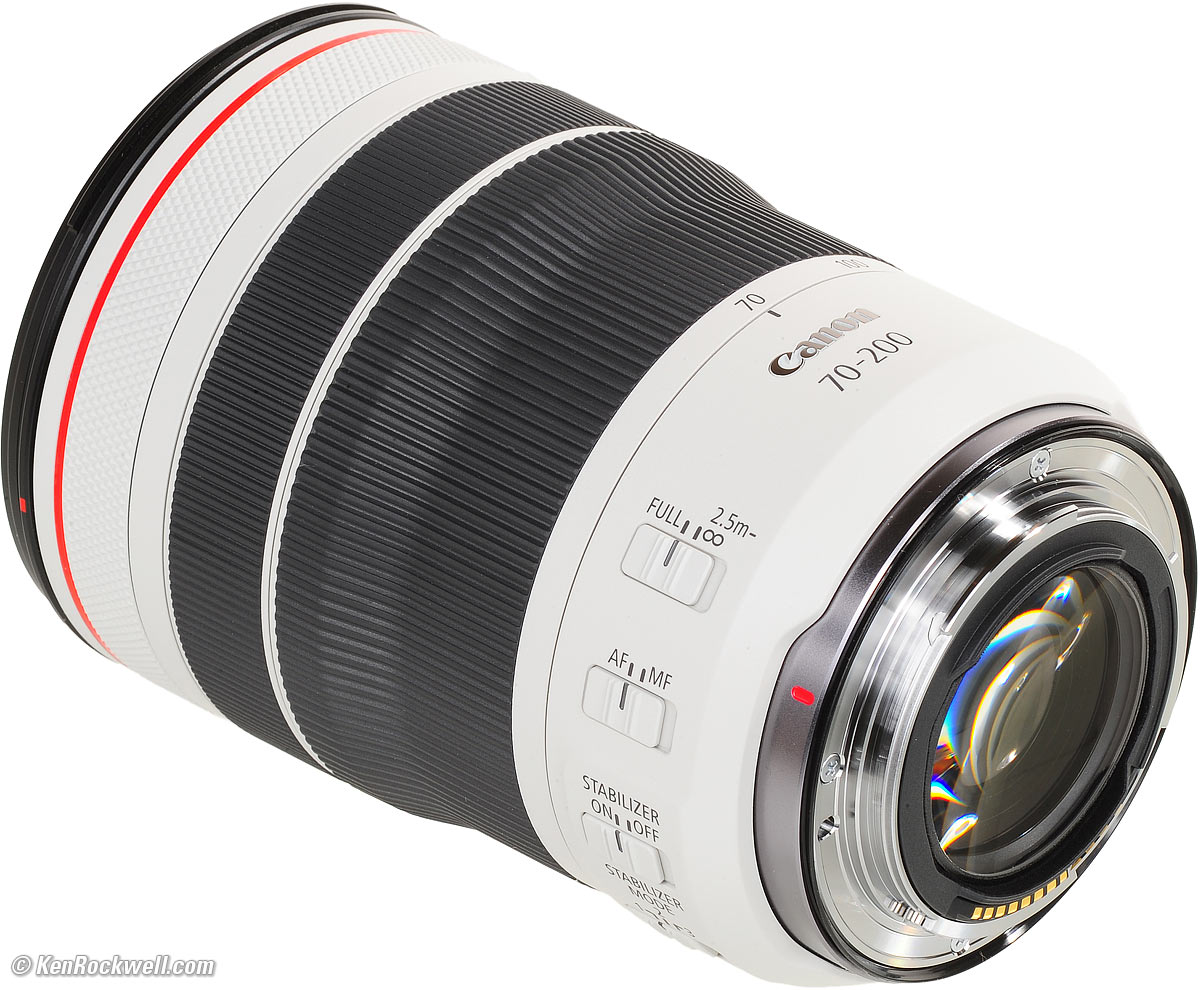
Canon RF 70-200mm f/4L IS USM. bigger.
This is made as Canon makes most of their pro lenses today: plastic on the outside for weight and to keep your fingers from freezing to it in the cold, and lots of metal on the inside where it counts.
As 70-200/4L lenses go, this RF lens is a very easy-to-carry and lightweight lens. Part of this is the use of a lot more plastic than on the other lenses; this RF lens is well made, and well made with a lot more plastic than other L lenses.
Finish
Tannish-white matte paint.
Hood
Plastic bayonet with locking pawl.
Front Bumper
None.
Filter Threads
Plastic.
Hood Bayonet Mount
Plastic.
Front Barrel
Plastic.
Extra White Control Ring
Plastic.
Focus Ring
Rubber-covered plastic.
Zoom Ring
Rubber-covered plastic.
Mid Barrel Exterior
Section with switches: plastic.
Slide Switches
Plastic.
Identity
Printed on a flat ring between filter threads and front element, also "70-200" printed on top of barrel.
Internals
I can see a lot of plastic, and suspect some of the internal barrels and cams are metal.
Dust Gasket at Mount
Yes.
Mount
Solid metal.
Markings
All paint; except "70-200" on top of barrel is engraved.
Serial Number
Canon RF 70-200mm f/4L IS. bigger.
Laser engraved on bottom of barrel.
Date Code
None found.
Noises When Shaken
Mild to moderate clunking from what sounds like uncaged focus and stabilization groups.
Looking through the front of the lens with power off, you can see the internal image stabilizing elements jiggling around. They don't lock when turned off.
Made in
Lens Made in Japan.
Hood made in China.
Sharpness performance top
Lens sharpness has nothing to do with picture sharpness; every lens made in the past 100 years is more than sharp enough to make super-sharp pictures if you know what you're doing. The only limitation to picture sharpness is your skill as a photographer. It's the least talented who spend the most time worrying about lens sharpness and blame crummy pictures on their equipment rather than themselves. Skilled photographers make great images with whatever camera is in their hands; I've made some of my best images of all time with an irreparably broken camera! Most pixels are thrown away before you see them, but camera makers don't want you to know that.
If you're not getting ultra-sharp pictures with this, be sure not to shoot at f/11 or smaller where all lenses are softer due to diffraction, always shoot at ISO 100 or below because cameras become softer at ISO 200 and above, avoid shooting across long distances over land which can lead to atmospheric heat shimmer, be sure everything is in perfect focus, set your camera's sharpening as you want it (I set mine to the maximum 7,5,5) and be sure nothing is moving, either camera or subject. If you want to ensure a soft image with any lens, shoot at f/16 at ISO 1,600 at default sharpening in daylight of subjects at differing distances in the same image.
People worry waaaaay too much about sharpness. It's not 1968 anymore when lenses often weren't that sharp and there could be significant differences among them; today they are all pretty much equally fantastic.
This is one of the sharpest zooms ever made, and in actual use, it's sharp from edge to edge all the time. Sharpness is the least important lens factor today; heck, even my EF 70-200mm f/4L IS (first version from 2006) is stellar on my 50MP 5DS/R (Canon's highest resolution camera of all time), as is my original 1989 EF 80-200mm f/2.8L.
This lens is so sharp that I should turn down the sharpening in my R5. I usually have my R5 set to 7,5,5 for sharpening (under MENU > CAMERA 3 > Picture Style), and at this 7,5,5 setting this lens is so sharp that it leads to "ringing" or white haloes around sharp lines. How's that for extreme sharpness? Obviously we all have different tastes, so set these as you prefer.
Wide-Open at f/4 at 70mm
Palms, 15:05 PM, 11 March 2021. Canon EOS R5, Canon RF 70-200mm f/4 L IS at 70 mm wide-open at f/4 hand-held at 1/1,250 at Auto ISO 100, -⅔ stops exposure compensation (LV 14.4), exactly as shot. bigger or camera-original 45MP © JPG file (16 MB).
Ultra sharp from corner-to-corner at 45MP. Remember that at f/4 not everything is in focus; that's not a lens defect.
Wide-Open at f/4 at 200mm
Palms, 15:06 PM, 11 March 2021. Canon EOS R5, Canon RF 70-200mm f/4 L IS at 200 mm wide-open at f/4 hand-held at 1/800 at Auto ISO 100, -⅔ stops exposure compensation (LV 13⅔), exactly as shot. bigger or camera-original 45MP © JPG file (13.5 MB).
Ultra sharp from corner-to-corner at 45MP. Remember that at f/4 not everything is in focus; that's not a lens defect.
Canon RF 70-200mm MTF at 70mm (left) and 200mm (right) wide-open at f/4 at 10 cyc/mm (black) and 30 cyc/mm (blue). Sagittal (solid) and meridional (dashed).
Spherochromatism performance top
Spherochromatism, also called secondary spherical chromatic aberration or "color bokeh," is an advanced form of spherical and chromatic aberration in a different dimension than lateral chromatic aberration. It happens mostly in fast normal and tele lenses when spherical aberration at the ends of the color spectrum are corrected differently than in the middle of the spectrum. Spherochromatism can cause colored fringes on out-of-focus highlights, usually seen as green fringes on backgrounds and magenta fringes on foregrounds. Spherochromatism is common in fast lenses of moderate focal length when shooting contrasty items at full aperture. It goes away as stopped down.
It has a little bit of cool - warm spherochromatism, but nothing to get excited about:
Mondaine A132.30348.11SBB at close-focus distance, 11:28 AM, 18 March 2021. Canon EOS R5, Canon RF 70-200mm f/4 L IS at 200 mm wide-open at f/4 hand-held at 1/3,200 at Auto ISO 100, +⅔ stops exposure compensation (LV 15.6), exactly as shot. bigger or camera-original © file.
1,200 × 900 pixel (6.8× magnification) crop from above. bigger or camera-original © file.
If this 1,200 × 900 pixel crop is about 3" (7.5cm) wide on your screen, the complete image would print at a large 14 × 21″ (35 × 55 cm) at this same high magnification.
If this 1,200 × 900 pixel crop is about 6" (15cm) wide on your screen, the complete image would print at a huge 27½ × 41¼″ (70 × 105 cm) at this same high magnification.
If this 1,200 × 900 pixel crop is about 12" (30cm) wide on your screen, the complete image would print at a mammoth 55 × 82½″ (1.4 × 2.1 meters) at this same extremely high magnification!
Image Stabilization performance top
Optical Image Stabilization (OIS or IS) works great at 70mm but not so well at 200mm. I get perfect sharpness most of the time hand-held, standing with no bracing or support, most of the time at 1/8 at 70mm but only at 1/60 at 200mm.
"Percent Perfectly Sharp Shots" are the percentage of frames with 100% perfect tripod-equivalent sharpness I get when I'm shooting hand-held while free-standing with no support or bracing. Hand tremor is a random occurrence, so at marginal speeds some frames will be perfectly sharp while others will be in various stages of blur — all at the same shutter speed. This rates what percentage of shots are perfectly sharp, not how sharp are all the frames:
At 70mm on EOS R5 (with additional in-body stabilization and Firmware 1.2.0)
| % Perfectly Sharp Shots | 1 |
1/2 |
1/4 |
1/8 |
1/15 |
1/30 |
1/60 |
1/125 |
1/250 |
| Stabilization ON | 0 |
10 |
80 |
83 |
90 |
100 |
100 |
100 |
100 |
| Stabilization OFF | 0 |
0 |
0 |
0 |
0 |
10 |
25 |
70 |
100 |
I see about five stops of real-world improvement.
At 200mm on EOS R5 (with additional in-body stabilization and Firmware 1.2.0)
| % Perfectly Sharp Shots | 1/2 |
1/4 |
1/8 |
1/15 |
1/30 |
1/60 |
1/125 |
1/250 |
1/500 |
| Stabilization ON | 0 |
10 |
0 |
30 |
33 |
100 |
100 |
100 |
100 |
| Stabilization OFF | 0 |
0 |
0 |
0 |
0 |
25 |
50 |
100 |
100 |
I see only about two stops of real-world improvement, which is poor.
Sunstars performance top
With a 9-bladed rounded diaphragm, I get great 18-pointed sunstars on brilliant points of light at the smaller apertures.
Ignore any crazy rainbow effects; these are sensor artifacts caused by taking a picture directly of the sun and exposing for the dark underside of the palm tree.
Click any to enlarge:
Click any to enlarge.
Teleconverters performance top
No teleconverters work with this lens. The RF 1.4× and RF 2× extenders both need to extend into the mount of the lens, and this lens has glass there so they interfere and won't mount.
Tripod Collar performance top
There is NO tripod collar. This lens is too small to need one; don't worry about it.
Compared top
Sample Images Introduction Compatibility
Specifications USA Version Performance
Compared User's Guide Recommendations
Canon RF 70-200/2.8 L IS & RF 70-200mm f/4 L IS. bigger.
Canon EF 100-400 II, EF 70-200/4, RF 70-200/2.8 & RF 70-200mm f/4 (all L IS). bigger.
These are all ultra-sharp lenses, and they all focus very close.
This newest RF 70-200mm f/4L IS is the smallest, lightest and closest focussing, however due to its 400mm focal length the EF 100-400 II has the largest macro reproduction ratio by a slight margin of 1:3.2 (0.31×).
User's Guide top
Sample Images Introduction Compatibility
Specifications USA Version Performance
Compared User's Guide Recommendations
I got my RF 70-200/4L IS at B&H. I'd also get mine at Adorama, at Amazon or at Crutchfield, or used at eBay if you know How to Win at eBay.
Manual-Focus Override
By default, there is no always-responsive instant manual-focus override as we take for granted in our DSLRs.
EOS R cameras need a menu setting changed for manual-focus override, otherwise the focus ring is always ignored in AF.
Find the "Lens electronic AF" option in your AF menu (AF 4 in EOS R5 and EOS R6 or CAMERA 8 in EOS RP), and set it to either "One‑Shot‑>enabled" or "One‑Shot‑>enabled (magnify)."
Canon should have it set this way by default, but they don't. No big deal now that I figured it out.
Now manual focus override works if you turn the ring while continuing to hold the shutter halfway, but only after focus locks in ONE SHOT. The focus ring is ignored in SERVO.
Canon RF 70-200mm f/4L IS USM. bigger.
Full / 2.5m-∞ Switch user's guide top
This is a focus limiter.
Leave it in FULL.
The 2.5m-∞ position prevents the lens from autofocusing closer than 2.5 meters (8 feet). Use this setting only if you're having a problem with the lens attempting to focus on irrelevant close items, or if for some reason the lens is "hunting" from near to far looking for distant subjects.
AF - MF Switch user's guide top
AF: Auto Focus, with instant manual focus override in ONE SHOT if set.
MF: Manual Focus only.
Stabilizer Switches user's guide top
ON / OFF
Leave it ON unless you're on a very sturdy tripod, or if you're making exposures longer than a second on any kind of tripod.
Stabilizer Mode 1 / 2 / 3
Mode 1: Normal.
Mode 2: Panning.
Mode 3: Same as mode one, but saves power because it only works when you take the picture, not when you're composing.
Tripod Collar user's guide top
There is NO tripod collar. This lens is too small to need one; don't worry about it.
Recommendations top
Sample Images Introduction Compatibility
Specifications USA Version Performance
Compared User's Guide Recommendations
The RF 70-200/4L IS USM offers full f/4L-grade performance in the smallest package ever, and focuses super-close and utra-fast.
I got my RF 70-200/4L IS USM at B&H. I'd also get mine at Adorama, at Amazon or at Crutchfield, or used at eBay if you know How to Win at eBay.
This lens is super compact and high-performance, however and when I'm shooting something serious I prefer my much larger EF 100-400mm L IS II because I often use the 200-400mm range, and my 100-400 focuses almost as close and almost as fast, and it works great even with stacked -II extenders. I haven't used a 70-200 lens in years ever since I upgraded to the EF 100-400mm L IS II, which I still prefer to the RF 100-500mm (why?). No extenders work with this RF lens.
I use a clear (UV) protective filter instead of a cap so I'm always ready to shoot instantly. I only use a cap when I throw this in a bag with other gear without padding — which is never. The UV filter never gets in the way, and never gets lost, either.
The best protective filter is the 77mm Hoya multicoated HD3 UV which uses hardened glass and repels dirt and fingerprints.
For less money, the B+W 77mm 010 is an excellent filter, as is the multicoated version and the basic multicoated Hoya filters or the 77mm Nikon Clear (NC - UV), but the Hoya HD3 is the toughest and the best.
Filters last a lifetime, so you may as well get the best. The Hoya HD3 stays cleaner than the others since it repels oil and dirt, and will outlast this lens.
All these filters are just as sharp and take the same pictures, the difference is how much abuse they'll take and stay clean and stay in one piece.
This all-content, junk-free website's biggest source of support is when you use those or any of these links to approved sources when you get anything, regardless of the country in which you live. Canon does not seal its boxes in any way, so never buy at retail or any other source not on my personally approved list since you'll have no way of knowing if you're missing accessories, getting a defective, damaged, returned, non-USA, store demo or used lens. I use the stores I do because they ship from secure remote warehouses where no one gets to touch your new camera before you do. Buy only from the approved sources I use myself for the best prices, service, return policies and selection.
Thanks for helping me help you!
Ken.
© Ken Rockwell. All rights reserved. Tous droits réservés. Alle Rechte vorbehalten.
Help Me Help You
I support my growing family through this website, as crazy as it might seem.
The biggest help is when you use any of these links when you get anything. It costs you nothing, and is this site's, and thus my family's, biggest source of support. These places always have the best prices and service, which is why I've used them since before this website existed. I recommend them all personally.
If you find this page as helpful as a book you might have had to buy or a workshop you may have had to take, feel free to help me continue helping everyone.
If you've gotten your gear through one of my links or helped otherwise, you're family. It's great people like you who allow me to keep adding to this site full-time. Thanks!
If you haven't helped yet, please do, and consider helping me with a gift of $5.00.
As this page is copyrighted and formally registered, it is unlawful to make copies, especially in the form of printouts for personal use. If you wish to make a printout for personal use, you are granted one-time permission only if you PayPal me $5.00 per printout or part thereof. Thank you!
Thanks for reading!
Ken.
